-
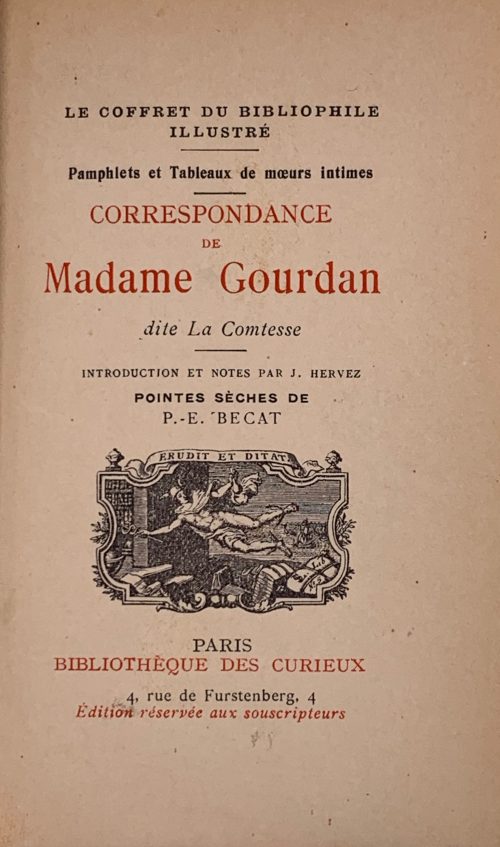 Front wrapper and title-page (in red and black): LE COFFRET DU BIBLIOPHILE ILLUSTRE | Pamphlets et Tableaux de mœurs intimes | CORRESPONDANCE | DE | Madame Gourdan | dite La Comtesse | INTRODUCTION ET NOTES PAR J. HERVEZ. | POINTES SÈCHES DE | P.-E. BECAT | {device} | PARIS | BIBLIOTHÈQUE DES CURIEUX | 4, rue de Furstenberg, 4 | Édition réservée aux souscripteurs || Limitation: L'édition illustrée du "Coffret | du bibliophile" est tirée à 750 | exemplaires, sur vergé de Rives, | – numérotés de 1 à 750 – | № 353 || Limited edition of 750 copies on Rives laid paper, of which this is copy № 353. Collation: fep, 3 blanks, front wrapper, 3 blanks vergé, [2] h.t. / limit., [2] t.p., [5] 6-188, blank, back wrapper, 3 blanks, fep., plus 12 plates, dry-points by P.-É. Bécat, extraneous to collation, incl. frontispiece. Binding: 16 x 10.3 cm, red crushed morocco, gilt lettering to spine, marbled endpapers, printed on laid paper, original wrappers preserved. Contributors: Marguerite Gourdan [Marguerite Alexandrine Ernestine Stock] (French, c. 1730 –1783) – fictional author. Jean Hervez (French, 1864 – ?) – author (preface). Charles Théveneau de Morande (French, 1741 – 1805) – presumable author of the text. Paul-Émile Bécat (French, 1885 – 1960) – artist. Bibliothèque des curieux [Georges & Robert Briffaut], Georges Briffaut (French, 1886 – 1973) – publisher. Previous editions: First published 1783, under the title: "Le portefeuille de Madame Gourdan" in London by Jean Nourse. Bibliothèque des curieux, 1910. Bibliothèque des curieux, 1924.
Front wrapper and title-page (in red and black): LE COFFRET DU BIBLIOPHILE ILLUSTRE | Pamphlets et Tableaux de mœurs intimes | CORRESPONDANCE | DE | Madame Gourdan | dite La Comtesse | INTRODUCTION ET NOTES PAR J. HERVEZ. | POINTES SÈCHES DE | P.-E. BECAT | {device} | PARIS | BIBLIOTHÈQUE DES CURIEUX | 4, rue de Furstenberg, 4 | Édition réservée aux souscripteurs || Limitation: L'édition illustrée du "Coffret | du bibliophile" est tirée à 750 | exemplaires, sur vergé de Rives, | – numérotés de 1 à 750 – | № 353 || Limited edition of 750 copies on Rives laid paper, of which this is copy № 353. Collation: fep, 3 blanks, front wrapper, 3 blanks vergé, [2] h.t. / limit., [2] t.p., [5] 6-188, blank, back wrapper, 3 blanks, fep., plus 12 plates, dry-points by P.-É. Bécat, extraneous to collation, incl. frontispiece. Binding: 16 x 10.3 cm, red crushed morocco, gilt lettering to spine, marbled endpapers, printed on laid paper, original wrappers preserved. Contributors: Marguerite Gourdan [Marguerite Alexandrine Ernestine Stock] (French, c. 1730 –1783) – fictional author. Jean Hervez (French, 1864 – ?) – author (preface). Charles Théveneau de Morande (French, 1741 – 1805) – presumable author of the text. Paul-Émile Bécat (French, 1885 – 1960) – artist. Bibliothèque des curieux [Georges & Robert Briffaut], Georges Briffaut (French, 1886 – 1973) – publisher. Previous editions: First published 1783, under the title: "Le portefeuille de Madame Gourdan" in London by Jean Nourse. Bibliothèque des curieux, 1910. Bibliothèque des curieux, 1924. -
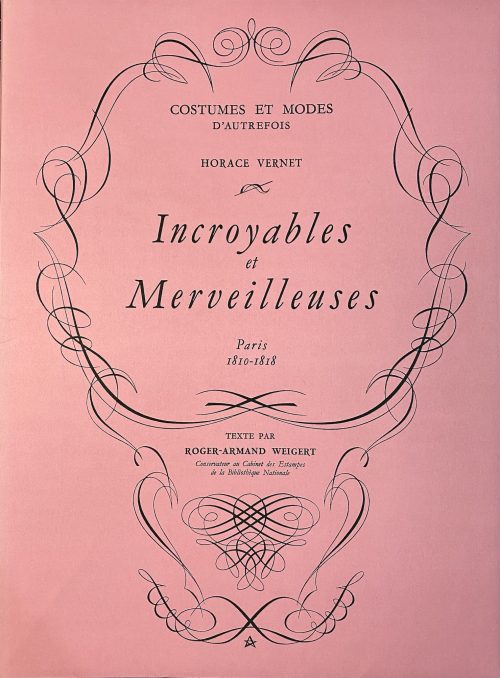 Title: COSTUMES ET MODES | D’AUTREFOIS | HORACE VERNET | Incroyables | et | Merveilleuses | Paris | 1810–1818 | TEXTE PAR | ROGER–ARMAND WEIGERT | Conservateur au Cabinet des Estampes | de la Bibliothèque Nationale | ÉDITIONS ROMBALDI | PARIS || Content: 24 photomechanical reproductions of the images from Bibliothèque nationale de France, printed on vélin paper from Papeteries Aussedat by Papeteries de la Moselle printing presses and stencil-coloured by Edmond Vairel. Text printed by Imprimerie Kapp on October 20, 1955. A print run of 4,000 copies, of which this is №122. Exterior: Pink lettered dust jacket over wrappers. Pagination: loose double leaves, [4 blanks] [4 h.t. and t.p.], i-xi [xii], 24 unnumbered plates, [4 blanks].
Title: COSTUMES ET MODES | D’AUTREFOIS | HORACE VERNET | Incroyables | et | Merveilleuses | Paris | 1810–1818 | TEXTE PAR | ROGER–ARMAND WEIGERT | Conservateur au Cabinet des Estampes | de la Bibliothèque Nationale | ÉDITIONS ROMBALDI | PARIS || Content: 24 photomechanical reproductions of the images from Bibliothèque nationale de France, printed on vélin paper from Papeteries Aussedat by Papeteries de la Moselle printing presses and stencil-coloured by Edmond Vairel. Text printed by Imprimerie Kapp on October 20, 1955. A print run of 4,000 copies, of which this is №122. Exterior: Pink lettered dust jacket over wrappers. Pagination: loose double leaves, [4 blanks] [4 h.t. and t.p.], i-xi [xii], 24 unnumbered plates, [4 blanks].Weigert, Roger-Armand (French, 1907-1986).
Émile Jean-Horace Vernet [Horace Vernet] (French, 1789 – 1863). Gatine, Georges Jacques (French, 1773 – after 1841). -
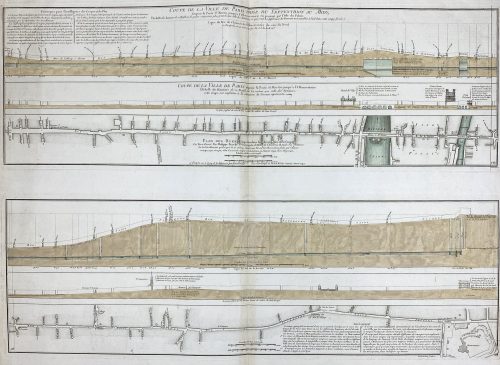
Two prints on one sheet of watermarked laid paper.
Coupe de la ville de Paris prise du septentrion au midy, depuis la porte St Martin jusqu'à l'Observatoire en passant par l'isle du Palais... Coupe de la ville de Paris depuis la porte St Martin jusqu'à l'Observatoire... Plan des rues comprises dans la direction dela coupe... / Le tout dressé par Philippe Buache... ; Desbruslins, sculpsit.
Watermark: "IHS" within circle; countermark of "FIN/ DUPUY/ AUVERGNE 1749".
LOC dates it to 1757. Gallica – to 1742, though the watermark is 1749.
-
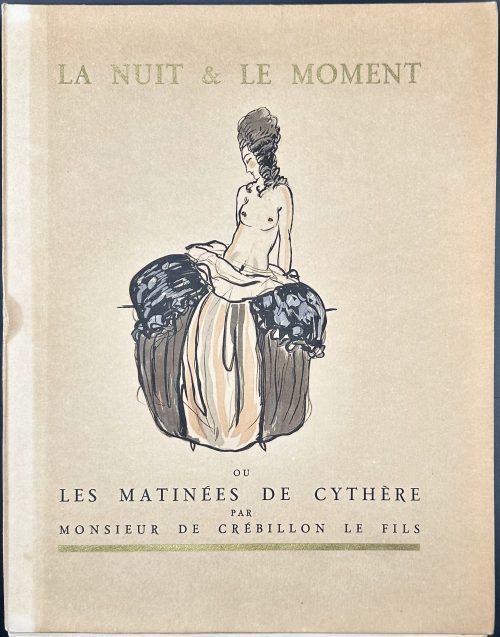 Softcover volume, 33 x 26 cm, collated in folio, not bound, in publisher’s French flapped pictorial wrappers, lettering to spine; printed on thick wove Arches paper watermarked “MBM”, upper edge trimmed, owner’s blind stamp to h.t. “Ex Libris Comte Tony de Vibraye”, glassine dust jacket, in a slipcase. Collation: π2 1-262, total 54 leaves, plus 4 leaves in wrappers, plus 10 plates, incl. frontispiece; coloured aquatints after Sylvain Sauvage; coloured etched vignette to front wrapper, gilt woodcut to back wrapper, woodcut title-page and woodcut headpiece after the same. Pp.: [4] [1] 2-102 [2]. Front wrapper (gilt and black): LA NUIT & LE MOMENT | {vignette} | OU | LES MATINÉES DE CYTHÈRE | PAR | MONSIEUR DE CRÉBILLON LE FILS | — || Title-page (woodcut): CRÉBILLON LE FILS | — | LA NUIT ET LE MOMENT | OU | LES MATINÉES | DE CYTHÈRE | {vignette} | A PARIS | AUX DEPENS D'UN AMATEUR | — | M CM XXIV || Limitation: De cette édition il a été tiré un exemplaire unique sur japon impérial comportant dix aquarelles originales, deux cents trente exemplaires sur vélin d' Arches numérotés 1 à 230, dont les dix premiers avec une suite de hors texte sur japon. N° 1 [Print run limited to 230 copies on Arches plus a unique copy on Japon with original watercolours, this is copy № 1 on wove paper]. Seller’s description: La Nuit et le moment ou Les Matinées de Cythère. Paris, Au dépens d'un amateur, 1924. In-4, en feuilles, non rogné, couverture illustrée et étui. Ouvrage illustré de 4 gravures sur bois et de 10 eaux-fortes libres en couleurs hors texte de Sylvain Sauvage. Tirage à 231 exemplaires, celui-ci le n°1 sur vélin d'Arches. Manque la suite de hors texte sur japon. De la bibliothèque du Comte Tony de Vibraye, avec cachet à froid. Dutel, n°2062. Catalogue raisonné: honesterotica.com; Dutel III 2062. Contributors: Claude-Prosper Jolyot de Crébillon [Crébillon fils] (French, 1707 – 1777) – author. Sylvain Sauvage [Félix Roy] (French, 1888 – 1948) – artist. Provenance: Antoine Henri Gaston Hurault de Vibraye [Comte Tony de Vibraye] (French, 1893 – 1951)
Softcover volume, 33 x 26 cm, collated in folio, not bound, in publisher’s French flapped pictorial wrappers, lettering to spine; printed on thick wove Arches paper watermarked “MBM”, upper edge trimmed, owner’s blind stamp to h.t. “Ex Libris Comte Tony de Vibraye”, glassine dust jacket, in a slipcase. Collation: π2 1-262, total 54 leaves, plus 4 leaves in wrappers, plus 10 plates, incl. frontispiece; coloured aquatints after Sylvain Sauvage; coloured etched vignette to front wrapper, gilt woodcut to back wrapper, woodcut title-page and woodcut headpiece after the same. Pp.: [4] [1] 2-102 [2]. Front wrapper (gilt and black): LA NUIT & LE MOMENT | {vignette} | OU | LES MATINÉES DE CYTHÈRE | PAR | MONSIEUR DE CRÉBILLON LE FILS | — || Title-page (woodcut): CRÉBILLON LE FILS | — | LA NUIT ET LE MOMENT | OU | LES MATINÉES | DE CYTHÈRE | {vignette} | A PARIS | AUX DEPENS D'UN AMATEUR | — | M CM XXIV || Limitation: De cette édition il a été tiré un exemplaire unique sur japon impérial comportant dix aquarelles originales, deux cents trente exemplaires sur vélin d' Arches numérotés 1 à 230, dont les dix premiers avec une suite de hors texte sur japon. N° 1 [Print run limited to 230 copies on Arches plus a unique copy on Japon with original watercolours, this is copy № 1 on wove paper]. Seller’s description: La Nuit et le moment ou Les Matinées de Cythère. Paris, Au dépens d'un amateur, 1924. In-4, en feuilles, non rogné, couverture illustrée et étui. Ouvrage illustré de 4 gravures sur bois et de 10 eaux-fortes libres en couleurs hors texte de Sylvain Sauvage. Tirage à 231 exemplaires, celui-ci le n°1 sur vélin d'Arches. Manque la suite de hors texte sur japon. De la bibliothèque du Comte Tony de Vibraye, avec cachet à froid. Dutel, n°2062. Catalogue raisonné: honesterotica.com; Dutel III 2062. Contributors: Claude-Prosper Jolyot de Crébillon [Crébillon fils] (French, 1707 – 1777) – author. Sylvain Sauvage [Félix Roy] (French, 1888 – 1948) – artist. Provenance: Antoine Henri Gaston Hurault de Vibraye [Comte Tony de Vibraye] (French, 1893 – 1951) -
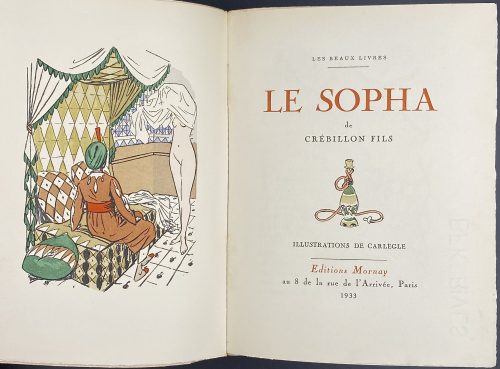 Title: LES BEAUX LIVRES | — | LE SOPHA | de | CRÉBILLON FILS |{vignette}| ILLUSTRATIONS DE CARLÈGLE | — | Éditions Mornay | au 8 de la rue de l’Arrivée, Paris | 1933 || Series: Les beaux livres Binding: Original pictorial wrappers, margins untrimmed, uncut; printed on BFK Rives paper (watermark); the number of copy blacked out. Justification of the print run on p. [329].Pagination: [1-8] 9-326 [327-331], ill., woodcuts in text. Size: 20.2 x 15.5 cm
Title: LES BEAUX LIVRES | — | LE SOPHA | de | CRÉBILLON FILS |{vignette}| ILLUSTRATIONS DE CARLÈGLE | — | Éditions Mornay | au 8 de la rue de l’Arrivée, Paris | 1933 || Series: Les beaux livres Binding: Original pictorial wrappers, margins untrimmed, uncut; printed on BFK Rives paper (watermark); the number of copy blacked out. Justification of the print run on p. [329].Pagination: [1-8] 9-326 [327-331], ill., woodcuts in text. Size: 20.2 x 15.5 cm -
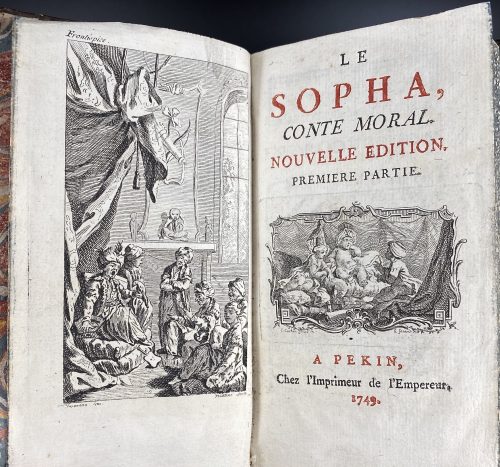 Title-page in black and red: LE | SOPHA, | CONTE MORAL. | NOUVELLE EDITION. | PREMIERE PARTIE. | {vignette} | A PEKIN, | Chez l'imprimeur de l'Empereur, | 1749. || Pagination: Two volumes in one. [2] – blanks, [2] – blank / frontis., [i, ii] – t.p. / blank, [iii] iv-xxi [xxii] ; [1] 2-253, [254-256] – table / blank, [2] – blanks; [i, ii] f.t. (seconde partie). [iii] 4-237 [238-240] – table / blank, [2] – blanks ; ills. 1 frontispiece, 4 plates and 2 vignettes by Pelletier after Clavereau, 2 fleurons by Fessard after Cochin. Collation: 12mo; a12, A8B4–T8V4, X8 [*1]; A8B4–T8V4. Binding: Full mottled calf, flat spine, compartments double-ruled in gilt, gilt flowers and foliage in compartments, crimson title label; marbled endpapers. Printed on laid paper, watermarked. Size: 14.8 x 8.8 cm Catalogue raisonné: Cohen, de Ricci (266); J. Lewine (124-5).
Title-page in black and red: LE | SOPHA, | CONTE MORAL. | NOUVELLE EDITION. | PREMIERE PARTIE. | {vignette} | A PEKIN, | Chez l'imprimeur de l'Empereur, | 1749. || Pagination: Two volumes in one. [2] – blanks, [2] – blank / frontis., [i, ii] – t.p. / blank, [iii] iv-xxi [xxii] ; [1] 2-253, [254-256] – table / blank, [2] – blanks; [i, ii] f.t. (seconde partie). [iii] 4-237 [238-240] – table / blank, [2] – blanks ; ills. 1 frontispiece, 4 plates and 2 vignettes by Pelletier after Clavereau, 2 fleurons by Fessard after Cochin. Collation: 12mo; a12, A8B4–T8V4, X8 [*1]; A8B4–T8V4. Binding: Full mottled calf, flat spine, compartments double-ruled in gilt, gilt flowers and foliage in compartments, crimson title label; marbled endpapers. Printed on laid paper, watermarked. Size: 14.8 x 8.8 cm Catalogue raisonné: Cohen, de Ricci (266); J. Lewine (124-5). -
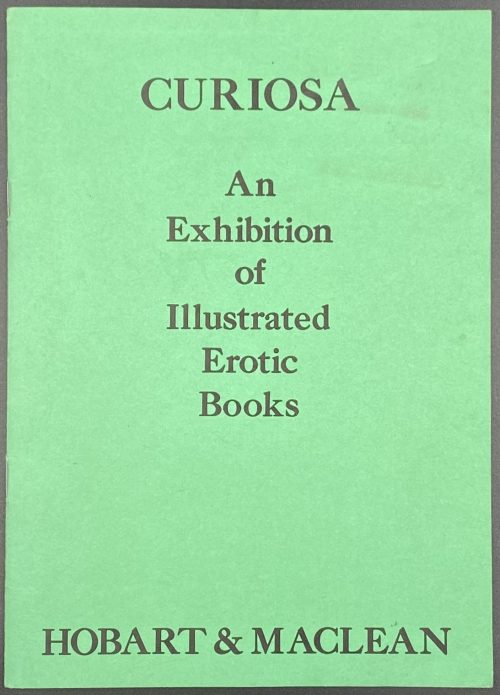 Title: CURIOSA | An | Exhibition | of | Illustrated | Erotic | Books | HOBART & MACLEAN || Pagination: 16 unpaginated pages with bibliography of 49 editions with prices and 51 images. Stapled softcover, original green wrappers with lettering to front and illustration to back. Size: 21 x 15 cm.
Title: CURIOSA | An | Exhibition | of | Illustrated | Erotic | Books | HOBART & MACLEAN || Pagination: 16 unpaginated pages with bibliography of 49 editions with prices and 51 images. Stapled softcover, original green wrappers with lettering to front and illustration to back. Size: 21 x 15 cm. -
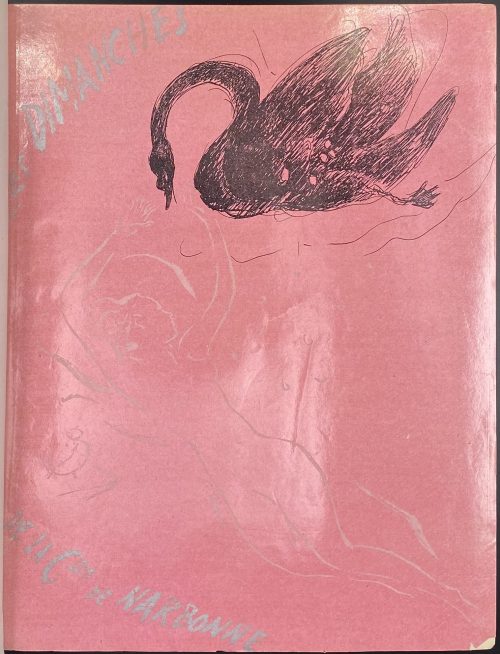 Description: Bound in brown ¾ morocco over marbled boards by R. et R. Mativet (ink stamp to ffep verso), collated 4to, 26.4 x 20.7 cm, raised bands, gilt arabesque and lettering to spine, original glossy pink pictorial wrappers preserved, marbled endpapers, bookplate to front pastedown “ML”, to front fep “EX-LIBRIS | Jacques | Crépineau”; A.L.s. of Marcel Vertès pasted to one of the feps: "Biblis [6] rue Jacques Callot. Cher Monsieur Le Bodo, Voudriez-vous avoir l’amabilité et de céder un exemplaire de « Dimanche » à M. Risler à un prix très réduit? Merci d’avance. Bien à vous, Vertès". Jean Le Bodo – abord gérant de la Librairie Biblis (20, rue du Vieux-Colombier, Paris 6e), et en 1946, libraire au Livre de France, Paris 16e; Risler – probablement Jean-François Risler (1910-1952), fils d’un pianiste Joseph-Édouard Risler (1873 – 1929). Title-page: DAISY FELLOWES | Les | Dimanches | de la | Csse de Narbonne | ILLUSTRATIONS | DE | VERTÈS | ÉDITIONS DE France | 20, AVENUE RAPP, PARIS || Collation: 1 blank, front wrapper, π4 (2 blanks with A.L.s. pasted to the 2nd, h.t., t.p.), 1-244 χ4 (table, colophon, 2 blanks) back wrapper, 1 blank; total 104 leaves within the wrappers, numerous in-text and 7 full-page prints after drawings by Marcel Vertès, within collation. Pagination: [8] [1-2] 3-191 [192] [8], total 208 pages, ils. Limitation: printed on June 25, 1935 by Coulouma (Argenteuil) under the direction of H. Barthélemy, 20 copies (№1-20) on Japon blanc super-nacré + two suites, 80 copies on Japon a la forme (№21-100) + one suite, 900 (№101-1000) on Vélin blanc. This is copy № 598. Catalogue raisonné: Vokaer (Vertès) № 34, p. 15. Provenance: Jacques Crepineau (French, 1932 – 2017). Contributors: Daisy Fellowes [Marguerite Séverine Philippine Decazes de Glücksberg] (French, 1890 – 1962) – author Marcel Vertès [Marcell Vértes] (Jewish-Hungarian-French, 1895 – 1961) – artist.
Description: Bound in brown ¾ morocco over marbled boards by R. et R. Mativet (ink stamp to ffep verso), collated 4to, 26.4 x 20.7 cm, raised bands, gilt arabesque and lettering to spine, original glossy pink pictorial wrappers preserved, marbled endpapers, bookplate to front pastedown “ML”, to front fep “EX-LIBRIS | Jacques | Crépineau”; A.L.s. of Marcel Vertès pasted to one of the feps: "Biblis [6] rue Jacques Callot. Cher Monsieur Le Bodo, Voudriez-vous avoir l’amabilité et de céder un exemplaire de « Dimanche » à M. Risler à un prix très réduit? Merci d’avance. Bien à vous, Vertès". Jean Le Bodo – abord gérant de la Librairie Biblis (20, rue du Vieux-Colombier, Paris 6e), et en 1946, libraire au Livre de France, Paris 16e; Risler – probablement Jean-François Risler (1910-1952), fils d’un pianiste Joseph-Édouard Risler (1873 – 1929). Title-page: DAISY FELLOWES | Les | Dimanches | de la | Csse de Narbonne | ILLUSTRATIONS | DE | VERTÈS | ÉDITIONS DE France | 20, AVENUE RAPP, PARIS || Collation: 1 blank, front wrapper, π4 (2 blanks with A.L.s. pasted to the 2nd, h.t., t.p.), 1-244 χ4 (table, colophon, 2 blanks) back wrapper, 1 blank; total 104 leaves within the wrappers, numerous in-text and 7 full-page prints after drawings by Marcel Vertès, within collation. Pagination: [8] [1-2] 3-191 [192] [8], total 208 pages, ils. Limitation: printed on June 25, 1935 by Coulouma (Argenteuil) under the direction of H. Barthélemy, 20 copies (№1-20) on Japon blanc super-nacré + two suites, 80 copies on Japon a la forme (№21-100) + one suite, 900 (№101-1000) on Vélin blanc. This is copy № 598. Catalogue raisonné: Vokaer (Vertès) № 34, p. 15. Provenance: Jacques Crepineau (French, 1932 – 2017). Contributors: Daisy Fellowes [Marguerite Séverine Philippine Decazes de Glücksberg] (French, 1890 – 1962) – author Marcel Vertès [Marcell Vértes] (Jewish-Hungarian-French, 1895 – 1961) – artist. -
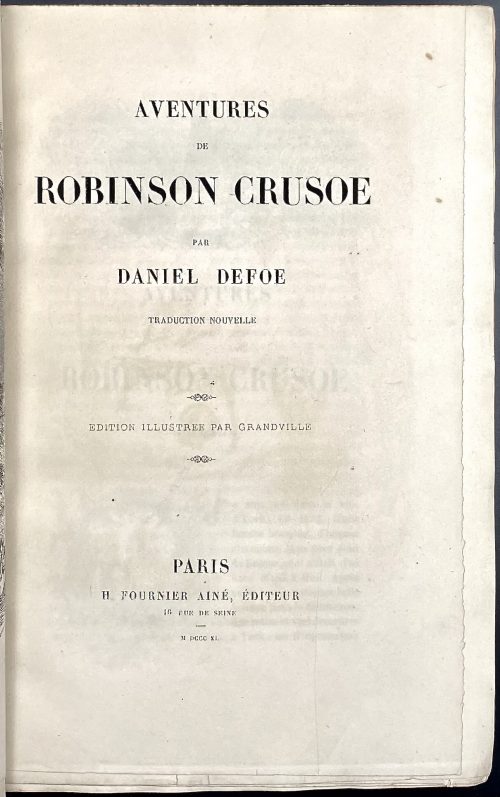 Title page: AVENTURES | DE | ROBINSON CRUSOE | PAR | DANIEL DEFOE | TRADUCTION NOUVELLE | ☙ |EDITION ILLUSTREE PAR GRANDVILLE | ❧ |PARIS | H. FOURNIER AINÉ, ÉDITEUR | 16 RUE DE SEINE | — | M DCCC XL || {sic: no accents in EDITION ILLUSTREE) Pagination: [4] [1]-610, [2] [1]-4., 620 pp. total plus 82 leaves of plates, unpaginated. Collation: 2 binder’s blank leaves, front publisher’s wrapper, h.t / imprint, 2 copies of engraved frontispiece on china paper, t.p. / blank, etc., … text..., back wrapper and spine bound in; 4to: π2 [1]-774 (310 leaves total) plus 40 x 2 plates extraneous to collation. Illustrations: 2 head- and 2 tailpieces, 2 initials, 159 vignettes, and 40 lettered plates each in two variants: one printed on a regular page, and one printed on India paper and pasted to a page. Page size: 24 x 15 cm. Frontispiece: Cut on wood by Louis-Henri Brevière after J. J. Grandville and Français. “Robinson sits on a throne-like chair framed by exotic palm trees. The sculptural and quasi-royal representation of Robinson is flanked by his faithful dog and parrot. The hero’s tools (the gun and the axe) are prominently displayed. He looks to the horizon away to the left, rather than to the tiny ship that can be seen on the horizon. His overcoming of life’s difficult events is at the core of the representation. The massive plinth reinforces the aura of the hero, as do the tiny people admiring the sculpture and learning about the heroic figure. Friday is discreetly represented in a medallion on the plinth along with other decorations including goats and a «savage»". [Sitzia, E. (2020). Lost in Intersemiotic Translation? J.J. Grandville’s Illustration of Robinson Crusoe. Journal for Literary and Intermedial Crossings, 5(2). https://clic.research.vub.be/sites/default/files/atoms/files/SITZIA_FIN.pdf] The monument has an inscription: “ FERNAND | SUEZ” which we deciphered as either a tribute to Juan Fernández (Spanish, c. 1536 – c. 1604) or as a mention of the place where Crusoe’s adventures took place: Archipiélago Juan Fernández to which Isla Róbinson Crusoe belongs. Binding: 24.8 x 16.4 cm, by Emile Mercier, half green crushed morocco over marbled boards, gilt-ruled, spine ornately gilt, sunned to orange tone, marbled endpapers, publisher's pale yellow wrappers bound in; only the top edge trimmed. Contributors: Daniel Defoe (British, 1660 – 1731) – author. J. J. Grandville [Gèrard, Isidore-Adolphe] (French, 1803 – 1847) – artist. François-Louis Français (French, 1814 – 1897) – artist (frontispiece, landscapes). Engravers: John Quartley (British, fl. 1835 – 1867) Matthew Urlwin Sears (British, 1799 – 1870) Adolphe Best (French, 1808 – 1860) One of the Guillaumots: Eugène Guillaumot (French, Paris 1813–1869), or Auguste Etienne Guillaumot (French,1844 – 1890), or his father Auguste-Alexandre Guillaumot (French, 1815 – 1892) Laisné [Alfred, Adèle, and Aglaé] (French, active 1835–1868) Antoine-Alphée Piaud (French, 1813 – 1867) Louis Dujardin (French, 1808 – 1859) A. Hans (nothing is known) Jean Louis Joseph Camille Lacoste (French, 1809 – 1866) Louis-Henri Brevière (French, 1797 – 1869) – vignettes. Provenance: Bishop, Cortlandt Field (American, 1870 – 1935) – bookplate; Mary S. Collins – bookplate by J. H. Fincken Robin F. Satinsky (American, 1919 – 2008) – Robin Collection bookplate. Catalogue raisonné: Brivois (1883) p. 155; Ray (French): № 193, p. 272; Carteret (1927): p. 241. All indicated in-8vo, which doesn't correspond to our in-4to copy.
Title page: AVENTURES | DE | ROBINSON CRUSOE | PAR | DANIEL DEFOE | TRADUCTION NOUVELLE | ☙ |EDITION ILLUSTREE PAR GRANDVILLE | ❧ |PARIS | H. FOURNIER AINÉ, ÉDITEUR | 16 RUE DE SEINE | — | M DCCC XL || {sic: no accents in EDITION ILLUSTREE) Pagination: [4] [1]-610, [2] [1]-4., 620 pp. total plus 82 leaves of plates, unpaginated. Collation: 2 binder’s blank leaves, front publisher’s wrapper, h.t / imprint, 2 copies of engraved frontispiece on china paper, t.p. / blank, etc., … text..., back wrapper and spine bound in; 4to: π2 [1]-774 (310 leaves total) plus 40 x 2 plates extraneous to collation. Illustrations: 2 head- and 2 tailpieces, 2 initials, 159 vignettes, and 40 lettered plates each in two variants: one printed on a regular page, and one printed on India paper and pasted to a page. Page size: 24 x 15 cm. Frontispiece: Cut on wood by Louis-Henri Brevière after J. J. Grandville and Français. “Robinson sits on a throne-like chair framed by exotic palm trees. The sculptural and quasi-royal representation of Robinson is flanked by his faithful dog and parrot. The hero’s tools (the gun and the axe) are prominently displayed. He looks to the horizon away to the left, rather than to the tiny ship that can be seen on the horizon. His overcoming of life’s difficult events is at the core of the representation. The massive plinth reinforces the aura of the hero, as do the tiny people admiring the sculpture and learning about the heroic figure. Friday is discreetly represented in a medallion on the plinth along with other decorations including goats and a «savage»". [Sitzia, E. (2020). Lost in Intersemiotic Translation? J.J. Grandville’s Illustration of Robinson Crusoe. Journal for Literary and Intermedial Crossings, 5(2). https://clic.research.vub.be/sites/default/files/atoms/files/SITZIA_FIN.pdf] The monument has an inscription: “ FERNAND | SUEZ” which we deciphered as either a tribute to Juan Fernández (Spanish, c. 1536 – c. 1604) or as a mention of the place where Crusoe’s adventures took place: Archipiélago Juan Fernández to which Isla Róbinson Crusoe belongs. Binding: 24.8 x 16.4 cm, by Emile Mercier, half green crushed morocco over marbled boards, gilt-ruled, spine ornately gilt, sunned to orange tone, marbled endpapers, publisher's pale yellow wrappers bound in; only the top edge trimmed. Contributors: Daniel Defoe (British, 1660 – 1731) – author. J. J. Grandville [Gèrard, Isidore-Adolphe] (French, 1803 – 1847) – artist. François-Louis Français (French, 1814 – 1897) – artist (frontispiece, landscapes). Engravers: John Quartley (British, fl. 1835 – 1867) Matthew Urlwin Sears (British, 1799 – 1870) Adolphe Best (French, 1808 – 1860) One of the Guillaumots: Eugène Guillaumot (French, Paris 1813–1869), or Auguste Etienne Guillaumot (French,1844 – 1890), or his father Auguste-Alexandre Guillaumot (French, 1815 – 1892) Laisné [Alfred, Adèle, and Aglaé] (French, active 1835–1868) Antoine-Alphée Piaud (French, 1813 – 1867) Louis Dujardin (French, 1808 – 1859) A. Hans (nothing is known) Jean Louis Joseph Camille Lacoste (French, 1809 – 1866) Louis-Henri Brevière (French, 1797 – 1869) – vignettes. Provenance: Bishop, Cortlandt Field (American, 1870 – 1935) – bookplate; Mary S. Collins – bookplate by J. H. Fincken Robin F. Satinsky (American, 1919 – 2008) – Robin Collection bookplate. Catalogue raisonné: Brivois (1883) p. 155; Ray (French): № 193, p. 272; Carteret (1927): p. 241. All indicated in-8vo, which doesn't correspond to our in-4to copy. -
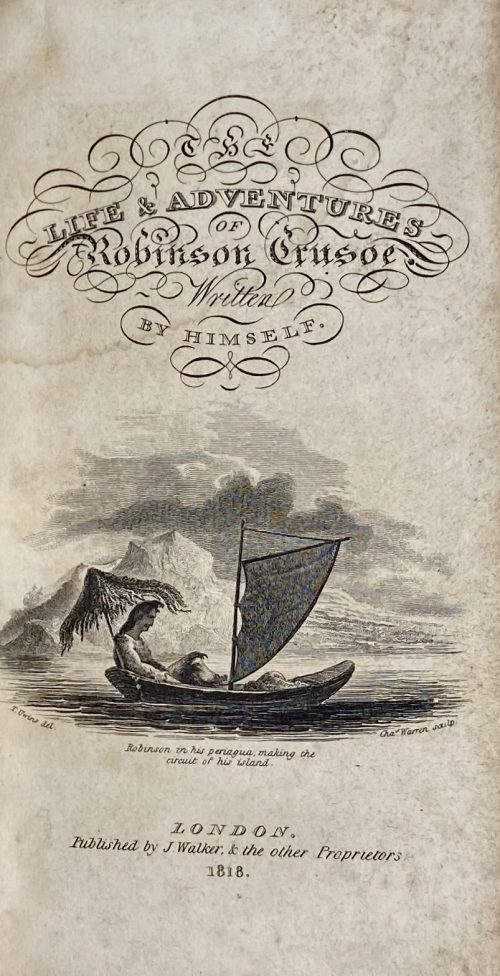 Description: 12mo, full calf, 12.9 x 7.4 cm, boards chain-bordered in gilt, front board gilt-lettered with the name of the owner “T. D. TOWNSEND”, flat spine, adorned in gilt, black label with gilt lettering, red endpapers, bookstore ticket to front pastedown: SOLD BY | ASH & MASON, | 139 Chesnut st.; ink ms inscription to ffep: Presented to | T. D. Townsend by | Mrs. Rebecca Cole of Burlington, N. Y. | Septr 29th 1827. Note: Ash & Mason bookstore and printing house in Philadelphia, PA. Engraved title-page: THE | LIFE & ADVENTURES | OF | Robinson Crusoe | Written | BY HIMSELF. | {vignette by C. Warren after T. Uwins, inscribed “Robinson on his periagua, making the circuit of his island”} | LONDON. | J. Walker & the other Proprietors | 1818. || Frontispiece: seated portrait of Robinson Crusoe in his bungalow with a dog and a cat by C. Warren after T. Uwins, inscribed below: ROBINSON CRUSOE | surrounded by his domestics || under the frame: T. Uwins del — C. Warren sculp.; beneath: London. Pub. by Walker & the other Proprietors || Title-page: THE | LIFE & ADVENTURES | OF | ROBINSON CRUSOE; | WRITTEN BY HIMSELF. | — | LONDON: | Printed for J. Walker; | 8 lines of names… and B. Reynolds. | 1818. || Collation: A6 (A1 torn out, A2 blank), B-Z12, 2A-2D12, 2E10 (2E8-10 blank); total 328 leaves plus two plates (engraved frontispiece and engraved title). Pagination: [2 torn out] [2 blank], [i-iii] iv-vi [2 blank] [1] 2-638 [6 blank]; total 656 pages, ill. Contributors: Daniel Defoe [Daniel De Foe] (British, 1660 – 1731) – author. Thomas Uwins (British, 1782 – 1857) – artist. Charles Warren (British, 1762 – 1823) – engraver. J Walker & Co. [Walker & Edwards] (London) – publisher. Ellerton and Henderson, Printers (London) – printer.
Description: 12mo, full calf, 12.9 x 7.4 cm, boards chain-bordered in gilt, front board gilt-lettered with the name of the owner “T. D. TOWNSEND”, flat spine, adorned in gilt, black label with gilt lettering, red endpapers, bookstore ticket to front pastedown: SOLD BY | ASH & MASON, | 139 Chesnut st.; ink ms inscription to ffep: Presented to | T. D. Townsend by | Mrs. Rebecca Cole of Burlington, N. Y. | Septr 29th 1827. Note: Ash & Mason bookstore and printing house in Philadelphia, PA. Engraved title-page: THE | LIFE & ADVENTURES | OF | Robinson Crusoe | Written | BY HIMSELF. | {vignette by C. Warren after T. Uwins, inscribed “Robinson on his periagua, making the circuit of his island”} | LONDON. | J. Walker & the other Proprietors | 1818. || Frontispiece: seated portrait of Robinson Crusoe in his bungalow with a dog and a cat by C. Warren after T. Uwins, inscribed below: ROBINSON CRUSOE | surrounded by his domestics || under the frame: T. Uwins del — C. Warren sculp.; beneath: London. Pub. by Walker & the other Proprietors || Title-page: THE | LIFE & ADVENTURES | OF | ROBINSON CRUSOE; | WRITTEN BY HIMSELF. | — | LONDON: | Printed for J. Walker; | 8 lines of names… and B. Reynolds. | 1818. || Collation: A6 (A1 torn out, A2 blank), B-Z12, 2A-2D12, 2E10 (2E8-10 blank); total 328 leaves plus two plates (engraved frontispiece and engraved title). Pagination: [2 torn out] [2 blank], [i-iii] iv-vi [2 blank] [1] 2-638 [6 blank]; total 656 pages, ill. Contributors: Daniel Defoe [Daniel De Foe] (British, 1660 – 1731) – author. Thomas Uwins (British, 1782 – 1857) – artist. Charles Warren (British, 1762 – 1823) – engraver. J Walker & Co. [Walker & Edwards] (London) – publisher. Ellerton and Henderson, Printers (London) – printer. -
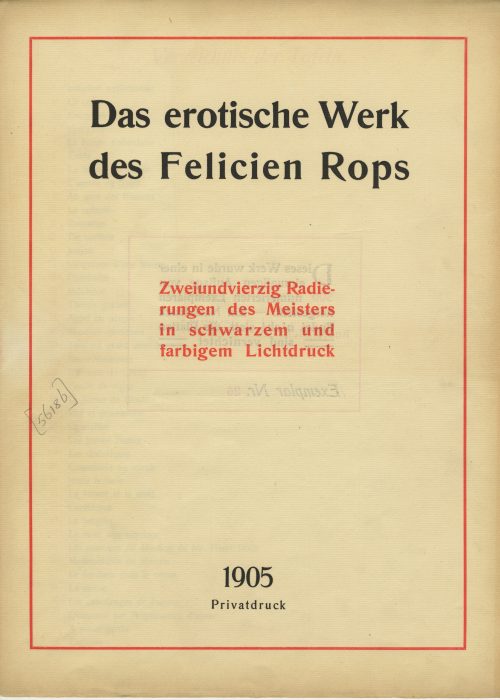
A limited-edition (№26/500) set of 42 etchings and drypoints after Félicien Rops (Belgian, 1833 – 1898), each mounted in a numbered passe-partout, printed posthumously by an anonym in Germany in 1905; in a flapped half faux suede-backed cardboard portfolio with straps, 442 x 335 mm, red embossed lettering to the front cover, bookplate of Richard Teschner (Austrian, 1879 – 1948) pasted inside.
Title-page (in a red frame): Das erotische Werk | des Felicien Rops | Zweiundvierzig Radie- | rungen des Meisters | in schwarzem und | farbigem Lichtdruck | 1905 | Privatdruk ||
Limitation (in a red two-section frame) : Dieses Werk wurde in einer | einmaligen Auflage von | 500 numerierten Exemplaren | hergestellt. — Ein Nachdruck | findet nicht statt, die Platten | == sind vernichtet == | Exemplar Nr. 26 ||
Verzeichnis der Tafeln (Table of Contents): 1. Initiation sentimentale; 2. La croix; 3. Entre-acte; 4. Holocauste; 5. La bonne hollandaise; 6. Étude; 7. La femme au pantin; 8. L’amour de Satan; 9. Au pays des féminies; 10. La volupté; 11. Evocation; 12. De castitate; 13. Joujou; 14. Vengeance d’une femme; 15. Phantasies; 16. Indolence; 17. Théâtre gaillard; 18. Appel au peuple; 19. Masques modernes; 20. Tout est grand chez les rois; 21. Marie-Madeleine; 22. L’amante du Christ; 23. Feuille de vigne; 24. La messe de Guide; 25 Viol et prostitution; 26. Le maillot; 27. Les jeunes France; 28. Les diaboliques; 29. Coquetterie au miroir; 30. Jeune homme; 31. La femme et la mort; 32. Confidence; 33. La bergère; 34. La mère aux satyrions; 35. Les exercices de dévotion de Mr. Henri Roch; 36. Mademoiselle de Maupin; 37. Le bonheur dans le crime; 38. La sirène; 39. Les cabotinages de l’amour; 40. Document sur l’impuissance d’aimer; 41. A cœur perdu; 42. Curieuse.
-
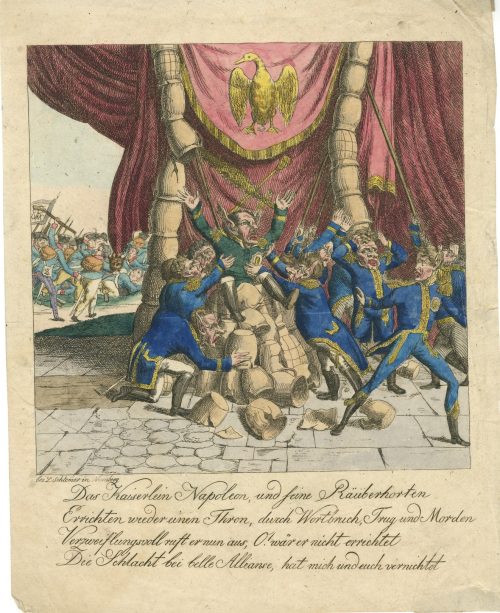 Hand-coloured etching by L. Schlemer from Nürnberg, printed in c. 1815. Napoleon, with long ears, is seated on a throne made of a pile of crockery, which is falling over. Referring to the Battle of Waterloo. See p. 134 in vol. 2 of A. M. Broadley. Napoleon in caricature, 1795-1821. — London, New York: John Lane, 1911.
Hand-coloured etching by L. Schlemer from Nürnberg, printed in c. 1815. Napoleon, with long ears, is seated on a throne made of a pile of crockery, which is falling over. Referring to the Battle of Waterloo. See p. 134 in vol. 2 of A. M. Broadley. Napoleon in caricature, 1795-1821. — London, New York: John Lane, 1911. -
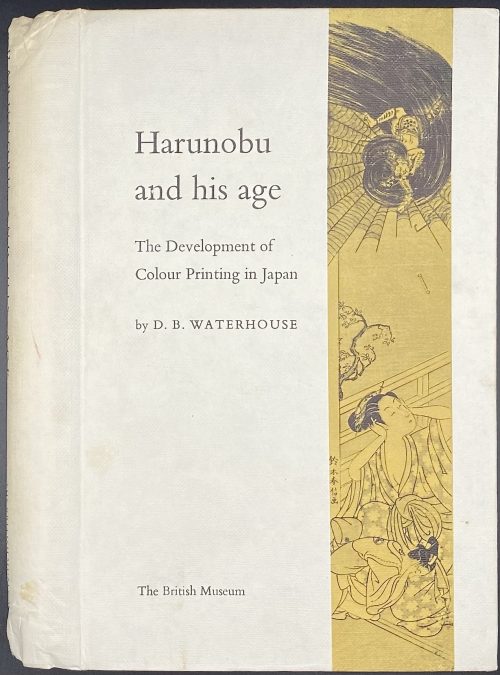
Pictorial cloth boards, spiral-bound, pp.: 3 leaves: h.t., frontis., t.p., 1-326; 123 black & white plates within the pagination.
-
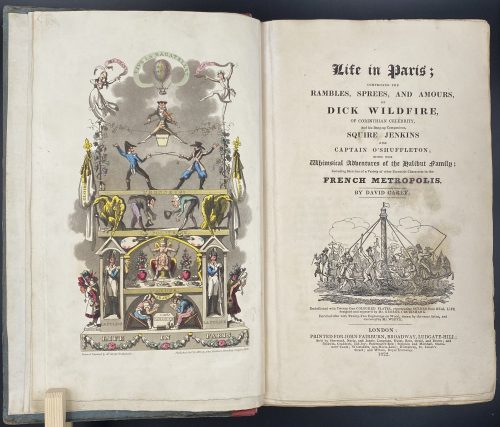
Title: Life in Paris ; | COMPRISING THE | RAMBLES, SPREES, AND AMOURS, | OF | DICK WILDFIRE, | OF CORINTHIAN CELEBRITY, | And his Bang-up Companions, SQUARE JENKINS | AND | CAPTAIN O’SHUFFLETON ; | WITH THE | Whimsical Adventures of the Halibut family ; | Including Sketches of a Variety of other Eccentric Characters in the | FRENCH METROPOLIS. | BY DAVID CAREY |[Vignette]| Embellished with Twenty-One COLOURED PLATES, representing SCENES from REAL LIFE, | designed and engraved by Mr. GEORGE CRUIKSHANK. | Enriched also with Twenty-Two Engravings on Wood, drawn by the same Artist, and | executed by Mr. WHITE. | LONDON : | PRINTED FOR JOHN FAIRBURN, BROADWAY, LUDGATE HILL; | Sold by Sherwood, Neely, and Jones ; Langman, Hurst, Rees, Orme, and Brown ; and | Baldwin, Craddoc, and Joy ; Paternoster-Row ; Simpkin and Marshall, Statio- | ners’ Court ; Whittakers Ave-Maria-Lane ; Humphrey, St. James’s | Street ; and Wilson, Royal Exchange. | 1822. ||
Edition: 1st edition in book form, 1st issue; large-paper copy bound from the parts in original blue paper boards, "most scarce" (Cohn).
Pagination: ffl, [i, ii] – h.t. ‘LIFE IN PARIS’ / ‘MARCHANT, Printer, Ingram-Court, London’, [2] – blank / Frontispiece (Ville la Bagatelle!!) hand-coloured, [iii, iv] – t.p. with vignette / blank, [v] vi-xxiv, [1] 2-489 [490 blank], [2] – 'TO THE BINDER' and 'Marchant, Printer, Ingram-Court, Fenchurch Street' "considered indispensable to a complete copy" (Cohn) / blank, bfl watermarked 1800; 21 hand-coloured aquatints and 22 wood-engraved text vignettes; cancelled leaves 143/4 and 335/6; pinholes from printing visible in most gatherings.
Collation: 4to; [a]-c4, B-Z4 Aa-Zz4 3A-3Q4 3R1 + [Ω]1
Binding: Original boards sometime re-backed with red paper, binder's end leaf watermarked 1800; red hard-grained morocco clamshell box.
Catalogue raisonné: Albert M. Cohn, 1924: № 109 p. 37/8; Abbey, J. R. (Life in England), 112; Tooley (Some English Books with Coloured Plates) 129; Hardie (English coloured books) 199.
Description of Shapero Rare Books, London: Of the copies that have come to auction since 1975 only one has been a large-paper copy in original boards. "The pictures are extremely spirited and true and are all the more wonderful in view of the fact that the artist’s continental experiences were limited to one day spent in Boulogne." (Hardie). In 1821, the journalist Pierce Egan published Life in London, an immediate success illustrated by the Cruikshank brothers, George and Robert. In order to capitalise on this success, another journalist, David Carey, decided to publish his own Life in Paris in monthly instalments (just like Life in London) and with a very similar frontispiece to the one that appears in Egan’s work; Life in Paris, however, was illustrated only by George Cruikshank. One of the earliest and most notable examples of the work of George Cruikshank, with fine, clean plates. -
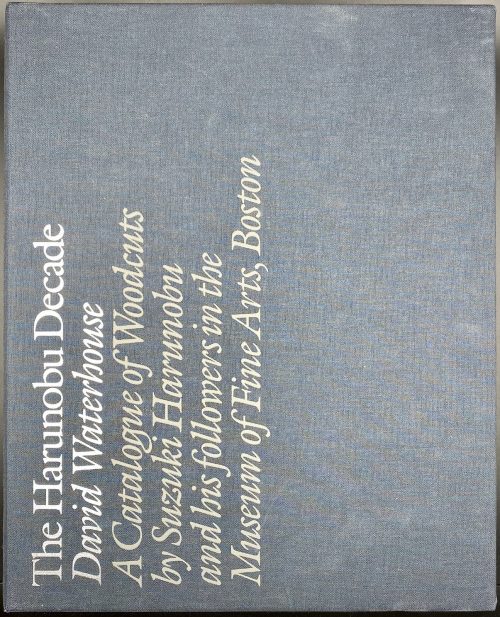 Two volumes in blue cloth, 30.3 x 25.2 cm each, in a matching slipcase 31.5 x 25.5 x 6.5 cm, with silver lettering. Vol. 1: Text, pp.: [1-8] 9-502 [2 blank]; Vol. 2: Plates, 240 unpaginated pages (721 entries). Suzuki Harunobu (Japanese, 1725 – 1770) David B. Waterhouse (British, 1936 – 2017)
Two volumes in blue cloth, 30.3 x 25.2 cm each, in a matching slipcase 31.5 x 25.5 x 6.5 cm, with silver lettering. Vol. 1: Text, pp.: [1-8] 9-502 [2 blank]; Vol. 2: Plates, 240 unpaginated pages (721 entries). Suzuki Harunobu (Japanese, 1725 – 1770) David B. Waterhouse (British, 1936 – 2017) -
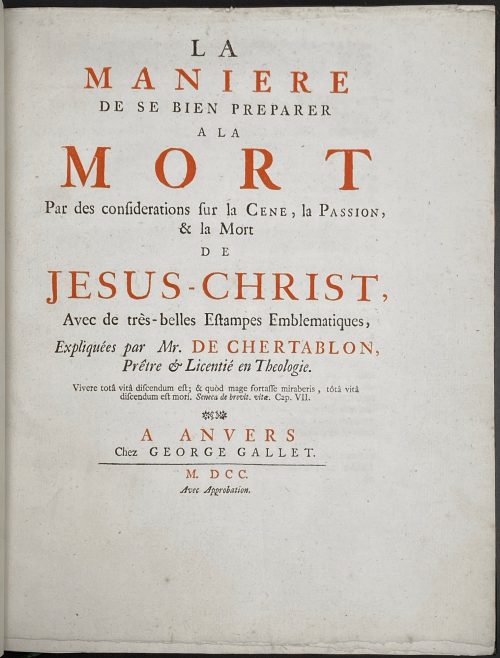 M. de Chertablon. La maniere de se bien preparer a la Mort par des Considerations sur la Cene, la Passion, et la Mort de Jesu-Christ. – Antwerp: George Gallet, 1700. Pagination: ff, [2 - blanks] [2 - t.p., blank] [3 - advert.] 4-63 [64]; 42 copper etched plates by Romeyn de Hooghe: A, B, C, 1-39; [20 - Dutch plate description of the David de la Vigne's Miroir de la bonne mort], bf. Full title: La maniere de se bien preparer a la Mort par des Considerations sur la Cene, la Passion, et la Mort de Jesu-Christ, Avec de très-belles Estampes Emblematiques, Expliquées par Mr. de Chertablon, Piêtre & Licentié en Theologie. Vivere totâ vitâ discendum est; & quòd mage fortasse miraberis, tôtâ vitâ discendum est mori. Seneca de brevit. vitæ. Cap. VII. A Anvers, Chez George Gallet. M DCC, Avec Approbation. / David de La Vigne. Spiegel om wel te sterven, annwyzende met beeltenissen van het lyden onses zaligmaakers Jesu Christi. Verzierd met 42 fyne Geërste Kopere Platen, Door Romain de Hooghe; Te Amsterdam, Voor dezen gedrukt by J. Stigter. Size: 4to, 27.2 x 21.6 cm. Binding: Late 19th century brown calf over marbled boards, spine with gilt lettering, raised bands, double fillet blind panels in compartments; marbled end-papers; bookplate of Samuel Ashton Thompson Yates library, AD 1894. Book illustrated with 42 copperplate etched engravings by Romeyn de Hooghe (Dutch, Amsterdam 1645–1708 Haarlem). According to Bonhams: the plates were "first printed for David de la Vigne's Miroir de la bonne mort. Each of the plates depicts a man contemplating a religious image in order to ease the passing of death, accompanied by commentary and an appropriate verse of scripture for each plate. The present French edition is bound with, as issued, the Dutch translation of David de La Vigne's aforementioned work."
M. de Chertablon. La maniere de se bien preparer a la Mort par des Considerations sur la Cene, la Passion, et la Mort de Jesu-Christ. – Antwerp: George Gallet, 1700. Pagination: ff, [2 - blanks] [2 - t.p., blank] [3 - advert.] 4-63 [64]; 42 copper etched plates by Romeyn de Hooghe: A, B, C, 1-39; [20 - Dutch plate description of the David de la Vigne's Miroir de la bonne mort], bf. Full title: La maniere de se bien preparer a la Mort par des Considerations sur la Cene, la Passion, et la Mort de Jesu-Christ, Avec de très-belles Estampes Emblematiques, Expliquées par Mr. de Chertablon, Piêtre & Licentié en Theologie. Vivere totâ vitâ discendum est; & quòd mage fortasse miraberis, tôtâ vitâ discendum est mori. Seneca de brevit. vitæ. Cap. VII. A Anvers, Chez George Gallet. M DCC, Avec Approbation. / David de La Vigne. Spiegel om wel te sterven, annwyzende met beeltenissen van het lyden onses zaligmaakers Jesu Christi. Verzierd met 42 fyne Geërste Kopere Platen, Door Romain de Hooghe; Te Amsterdam, Voor dezen gedrukt by J. Stigter. Size: 4to, 27.2 x 21.6 cm. Binding: Late 19th century brown calf over marbled boards, spine with gilt lettering, raised bands, double fillet blind panels in compartments; marbled end-papers; bookplate of Samuel Ashton Thompson Yates library, AD 1894. Book illustrated with 42 copperplate etched engravings by Romeyn de Hooghe (Dutch, Amsterdam 1645–1708 Haarlem). According to Bonhams: the plates were "first printed for David de la Vigne's Miroir de la bonne mort. Each of the plates depicts a man contemplating a religious image in order to ease the passing of death, accompanied by commentary and an appropriate verse of scripture for each plate. The present French edition is bound with, as issued, the Dutch translation of David de La Vigne's aforementioned work." -
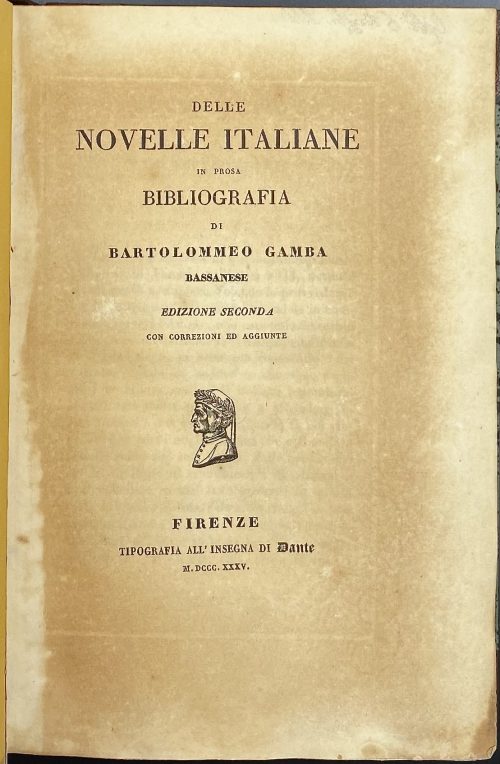 Title-page: DELLE | NOVELLE ITALIANE | IN PROSA | BIBLIOGRAFIA | DI | BARTOLOMMEO GAMBA | BASSANESE | EDIZIONE SECONDA | CON CORREZIONI ED AGGIUNTE | {publisher’s device} | FIRENZE | TIPOGRAFIA ALL’INSEGNA DI Dante | M.DCCC.XXXV. || Collation: 8vo; π8 1-198; an extra leaf between 18 and 19 (189, pp. 289-10, errata), leaf 11 unsigned, leaf 12 signed 11. Total 161 leaves plus 6 leaves of plates extraneous to collation; Plates (copperplate engravings): (1) Giovanni Boccaccio, (2) Angelo Firezuola (i.e. Agnolo Firenzuola), (3) Lorenzo Magalotti, (4) Gasparo Gozzi, and (5) Michele Colombo by Marco Comirato, and (6) Franco Sacchetti by Francesco Bosa. Pagination: [i-iii] iv-xv [xvi] [1-3] 4-290, index [16], total 322 pages plus 6 plates, unpaginated. Binding: 22.4 x 15 cm, modern brown half-morocco over green sprinkled boards, red label with gilt lettering, publisher’s yellow wrappers preserved. Edition: 2nd; the 1st edition was published in 1833. Contributors: Bartolommeo Gamba (Italian, 1766 – 1841) – author, complier. Marco Comirato (Italian, c. 1800 – 1869) – engraver. Francesco Bosa (Italian, ? – ?) – engraver. Sitters: Giovanni Boccaccio (Italian, 1313 –1375) Franco Sacchetti (Italian, c. 1335 – c. 1400) Agnolo Firenzuola] (Italian, 1493 – 1543) Lorenzo Magalotti (Italian, 1637 – 1712) Gasparo Gozzi (Italian, 1713 – 1786) Michele Colombo (Italian, 1747 – 1838)
Title-page: DELLE | NOVELLE ITALIANE | IN PROSA | BIBLIOGRAFIA | DI | BARTOLOMMEO GAMBA | BASSANESE | EDIZIONE SECONDA | CON CORREZIONI ED AGGIUNTE | {publisher’s device} | FIRENZE | TIPOGRAFIA ALL’INSEGNA DI Dante | M.DCCC.XXXV. || Collation: 8vo; π8 1-198; an extra leaf between 18 and 19 (189, pp. 289-10, errata), leaf 11 unsigned, leaf 12 signed 11. Total 161 leaves plus 6 leaves of plates extraneous to collation; Plates (copperplate engravings): (1) Giovanni Boccaccio, (2) Angelo Firezuola (i.e. Agnolo Firenzuola), (3) Lorenzo Magalotti, (4) Gasparo Gozzi, and (5) Michele Colombo by Marco Comirato, and (6) Franco Sacchetti by Francesco Bosa. Pagination: [i-iii] iv-xv [xvi] [1-3] 4-290, index [16], total 322 pages plus 6 plates, unpaginated. Binding: 22.4 x 15 cm, modern brown half-morocco over green sprinkled boards, red label with gilt lettering, publisher’s yellow wrappers preserved. Edition: 2nd; the 1st edition was published in 1833. Contributors: Bartolommeo Gamba (Italian, 1766 – 1841) – author, complier. Marco Comirato (Italian, c. 1800 – 1869) – engraver. Francesco Bosa (Italian, ? – ?) – engraver. Sitters: Giovanni Boccaccio (Italian, 1313 –1375) Franco Sacchetti (Italian, c. 1335 – c. 1400) Agnolo Firenzuola] (Italian, 1493 – 1543) Lorenzo Magalotti (Italian, 1637 – 1712) Gasparo Gozzi (Italian, 1713 – 1786) Michele Colombo (Italian, 1747 – 1838) -
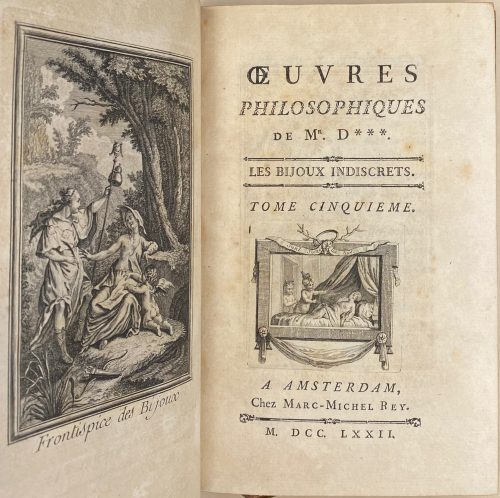 One volume, collated 8vo, 19.5 x 13 cm, later bound in brown full morocco by Pouillet, gilt-bordered covers, raised bands to spine, gilt in compartments, gilt-lettered, double-fillet on cover edges, gilt dentelle inside, signed, all edges gilt, marbled endpapers. Title-page: ŒUVRES | PHILOSOPHIQUES | DE MR. D ***. | — | LES BIJOUX INDISCRETS | — | TOME CINQUIEME | {vignette} | A AMSTERDAM, | Chez Marc-Michel Rey. | — | M. DCC. LXXII. || Pagination: [8] [1] 2-389 [390], total 398 pages, frontis., vignette, plates. Collation: 3 blank leaves at front and rear, π2 a2 A-Aa8 Bb3, total 199 leaves plus 7 unsigned engraved plates incl. frontispiece, and engraved vignette to t.p. Catalogue raisonné: Cohen-DeRicci 303; Lewine 145-6: …with the plates which have been copied and reduced in the undated Cazin edition (1771 and 1785). Contributors: Marc-Michel Rey (Dutch, 1720 – 1780) – publisher. Denis Diderot (French, 1713 – 1784) – author.
One volume, collated 8vo, 19.5 x 13 cm, later bound in brown full morocco by Pouillet, gilt-bordered covers, raised bands to spine, gilt in compartments, gilt-lettered, double-fillet on cover edges, gilt dentelle inside, signed, all edges gilt, marbled endpapers. Title-page: ŒUVRES | PHILOSOPHIQUES | DE MR. D ***. | — | LES BIJOUX INDISCRETS | — | TOME CINQUIEME | {vignette} | A AMSTERDAM, | Chez Marc-Michel Rey. | — | M. DCC. LXXII. || Pagination: [8] [1] 2-389 [390], total 398 pages, frontis., vignette, plates. Collation: 3 blank leaves at front and rear, π2 a2 A-Aa8 Bb3, total 199 leaves plus 7 unsigned engraved plates incl. frontispiece, and engraved vignette to t.p. Catalogue raisonné: Cohen-DeRicci 303; Lewine 145-6: …with the plates which have been copied and reduced in the undated Cazin edition (1771 and 1785). Contributors: Marc-Michel Rey (Dutch, 1720 – 1780) – publisher. Denis Diderot (French, 1713 – 1784) – author. -
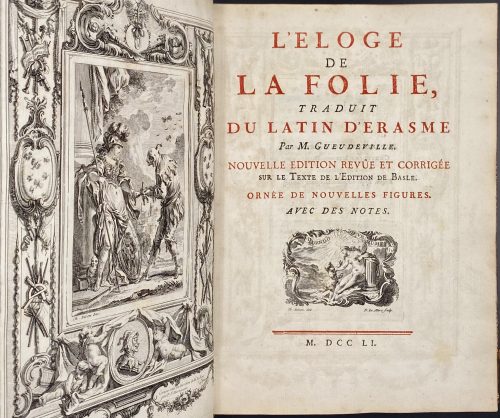 Title: L'ELOGE | DE | LA FOLIE, | TRADUIT | DU LATIN D'ERASME | Par M. Gueudeville. | NOUVELLE EDITION REVÛE & CORRIGÉE | sur le Texte de l'Edition de Basle. | ORNÉE DE NOUVELLES FIGURES. | AVEC DES NOTES. | {vignette Eisen / Le Mire} | — | M. DCC LI. || Pagination: [2 blank] [2] – h.t. / blank, [2] – t.p. / {citation*} | [4] – explication des figures; [i] ii-xxiv, [1] 2-222, [2] – table, [2 blank], plus frontispiece and 13 plates by various engravers after Charles Eisen, total number of pages 10+24+222+4=260, ils. Collation: 4to; [1 blank], π4 a-c4 A-Ee4 [1 blank], total number of leaves 130 plus frontispiece and 13 plates. Plates printed in black, paper 24 x 17.8 cm (grand papeir, 9.5 x 7 inches). Binding: Contemporary mottled calf, triple fillet gilt border with pomegranate corner pieces to boards, spine with raised bands, gilt foliage and pomegranates in compartments, red morocco spine label, all edges gilt, rebacked preserving the original spine and peacock marbled endpapers. Size: 24.8 x 18.8 cm; leaves 24 x 17.8 cm; text printed area: 10 x 6 cm. * Citattion: Admonere voluimus, non lædere: | Consulere moribus Hominum, | non officere. | Erasm. Epist. ad Mart. Dorpium Theolog. Usually, the citation is "Admonere voluimus, non mordere; prodesse, non laedere…", etc. Rococo-framed frontispiece engraved by Martinasie under the supervision of Le Bas. Contributors: Erasmus, Desiderius [Roterodamus] (Dutch, 1466 – 1536) – author. Gueudeville, Nicolas (French, 1652 – 1721) – translator. Meusnier de Querlon, Anne-Gabriel (French, 1702 – 1780) – notes. Eisen, Charles (French, 1720 – 1778) – artist. Engravers: Aliamet, Jacques (French, 1726 – 1788) Flipart, Charles Joseph (French, 1721 – 1797) Beauvais, Nicolas Dauphin de (French, 1687 – 1736) Pinssio [Pincio], Sébastien (French, 1721 – after 1744) Martenasie, Pierre François (French-Flemish, 1729 – 1789) Le Bas [Lebas], Jacques-Philippe (French, 1707 – 1783) Provenance: Bishop, Cortlandt Field (American, 1870 – 1935) – bookplate. Mary S. Collins – bookplate by J. H. Fincken. Robin F. Satinsky (American, 1919 – 2008) – Robin Collection bookplate. Catalogue raisonné: Cohen–deRichi 348-349; Lewine, p. 170; Ray (French) № 24, pp. 52-54.
Title: L'ELOGE | DE | LA FOLIE, | TRADUIT | DU LATIN D'ERASME | Par M. Gueudeville. | NOUVELLE EDITION REVÛE & CORRIGÉE | sur le Texte de l'Edition de Basle. | ORNÉE DE NOUVELLES FIGURES. | AVEC DES NOTES. | {vignette Eisen / Le Mire} | — | M. DCC LI. || Pagination: [2 blank] [2] – h.t. / blank, [2] – t.p. / {citation*} | [4] – explication des figures; [i] ii-xxiv, [1] 2-222, [2] – table, [2 blank], plus frontispiece and 13 plates by various engravers after Charles Eisen, total number of pages 10+24+222+4=260, ils. Collation: 4to; [1 blank], π4 a-c4 A-Ee4 [1 blank], total number of leaves 130 plus frontispiece and 13 plates. Plates printed in black, paper 24 x 17.8 cm (grand papeir, 9.5 x 7 inches). Binding: Contemporary mottled calf, triple fillet gilt border with pomegranate corner pieces to boards, spine with raised bands, gilt foliage and pomegranates in compartments, red morocco spine label, all edges gilt, rebacked preserving the original spine and peacock marbled endpapers. Size: 24.8 x 18.8 cm; leaves 24 x 17.8 cm; text printed area: 10 x 6 cm. * Citattion: Admonere voluimus, non lædere: | Consulere moribus Hominum, | non officere. | Erasm. Epist. ad Mart. Dorpium Theolog. Usually, the citation is "Admonere voluimus, non mordere; prodesse, non laedere…", etc. Rococo-framed frontispiece engraved by Martinasie under the supervision of Le Bas. Contributors: Erasmus, Desiderius [Roterodamus] (Dutch, 1466 – 1536) – author. Gueudeville, Nicolas (French, 1652 – 1721) – translator. Meusnier de Querlon, Anne-Gabriel (French, 1702 – 1780) – notes. Eisen, Charles (French, 1720 – 1778) – artist. Engravers: Aliamet, Jacques (French, 1726 – 1788) Flipart, Charles Joseph (French, 1721 – 1797) Beauvais, Nicolas Dauphin de (French, 1687 – 1736) Pinssio [Pincio], Sébastien (French, 1721 – after 1744) Martenasie, Pierre François (French-Flemish, 1729 – 1789) Le Bas [Lebas], Jacques-Philippe (French, 1707 – 1783) Provenance: Bishop, Cortlandt Field (American, 1870 – 1935) – bookplate. Mary S. Collins – bookplate by J. H. Fincken. Robin F. Satinsky (American, 1919 – 2008) – Robin Collection bookplate. Catalogue raisonné: Cohen–deRichi 348-349; Lewine, p. 170; Ray (French) № 24, pp. 52-54. -
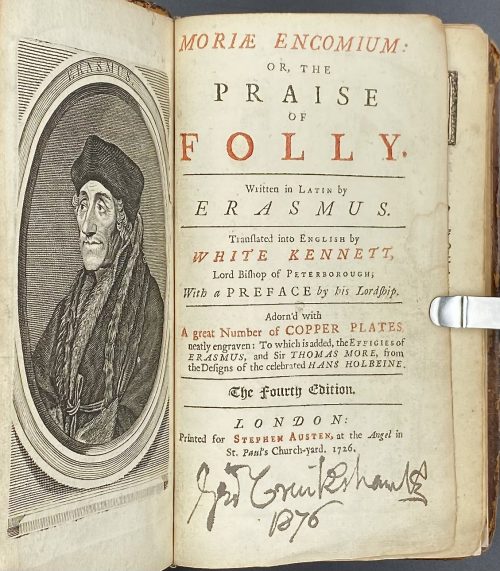 Erasmus. The praise of folly / Translated by White Kennett. — London: Stephen Austen, 1726. Title page in black and red: MORIÆ ENCOMIUM: | OR, THE | PRAISE | OF | FOLLY. |—| Written in Latin by | ERASMUS. |—| Translated into English by | WHITE KENNETT, | Lord Bishop of Peterborough; | With a PREFACE by his Lordship. |—| Adorn’d with | A great Number of COPPER PLATES | neatly engraven: To which is added, the Effigies of | ERASMUS, and Sir THOMAS MORE, from | theDesigns of the celebrated HANS HOLBEINE. |—| (in gothic letters) The Fourth Edition. |—| LONDON: | Printed for Stephen Austen, at the Angel in | St. Pauls’ Church-yard. 1726. || Pagination: modern endpapers and flyleaves, [2] – blank / frontis. (engraved portrait of Erasmus, [2] – t.p. in black and red with George Cruikshank’s signature in the bottom, dated 1876 / blank, [14] – to the reader, i-xiv – commendatory verses, [2] – John Wilford advert., folding portrait of Thomas More, i-v, [vi] - epistle, 1-168 – panegyrick, [4] – index.; 46 copper-engraved illustrations after Hans Holbein the Younger; pp. 17-20 detached. Collation: 12mo; π2 A6, a-b6, B-P6 Q2 (B3 unsigned), 13 in-text engravings + 26 plates + 7 folding plates; total 106 leaves and 33 plates, extraneous to collation. Edition: 4th, thus. Binding: 16.5 x 10.5 cm; rebacked with a modern spine, modern endpapers and flyleaves, contemporary boards sprinkled and tooled in a style of Cambridge panel. Provenance: Cruikshank, George (British, 1792 – 1878) [1876]; Stephen Whitehead (Oakland, CA) [2021]. Catalogue raisonné: J. Lewine (1898) p. 171 — 1st edition thus of 1709, in-8vo, with portrait and 46 plates after Holbein. Contributors: Desiderius Erasmus Roterodamus (Dutch, c. 1469 – 1536) – author of the original text in Latin.
Erasmus. The praise of folly / Translated by White Kennett. — London: Stephen Austen, 1726. Title page in black and red: MORIÆ ENCOMIUM: | OR, THE | PRAISE | OF | FOLLY. |—| Written in Latin by | ERASMUS. |—| Translated into English by | WHITE KENNETT, | Lord Bishop of Peterborough; | With a PREFACE by his Lordship. |—| Adorn’d with | A great Number of COPPER PLATES | neatly engraven: To which is added, the Effigies of | ERASMUS, and Sir THOMAS MORE, from | theDesigns of the celebrated HANS HOLBEINE. |—| (in gothic letters) The Fourth Edition. |—| LONDON: | Printed for Stephen Austen, at the Angel in | St. Pauls’ Church-yard. 1726. || Pagination: modern endpapers and flyleaves, [2] – blank / frontis. (engraved portrait of Erasmus, [2] – t.p. in black and red with George Cruikshank’s signature in the bottom, dated 1876 / blank, [14] – to the reader, i-xiv – commendatory verses, [2] – John Wilford advert., folding portrait of Thomas More, i-v, [vi] - epistle, 1-168 – panegyrick, [4] – index.; 46 copper-engraved illustrations after Hans Holbein the Younger; pp. 17-20 detached. Collation: 12mo; π2 A6, a-b6, B-P6 Q2 (B3 unsigned), 13 in-text engravings + 26 plates + 7 folding plates; total 106 leaves and 33 plates, extraneous to collation. Edition: 4th, thus. Binding: 16.5 x 10.5 cm; rebacked with a modern spine, modern endpapers and flyleaves, contemporary boards sprinkled and tooled in a style of Cambridge panel. Provenance: Cruikshank, George (British, 1792 – 1878) [1876]; Stephen Whitehead (Oakland, CA) [2021]. Catalogue raisonné: J. Lewine (1898) p. 171 — 1st edition thus of 1709, in-8vo, with portrait and 46 plates after Holbein. Contributors: Desiderius Erasmus Roterodamus (Dutch, c. 1469 – 1536) – author of the original text in Latin.White Kennett (British, 1660 – 1728) – translator from Latin into English.
Hans Holbein the Younger (German, 1497/8 – 1543) – artist.
Stephen Austen (fl. c. 1727 – 1746) – publisher. Linked items: Engraved portrait of Erasmus of Rotterdam in an octagonal frame, 1757 by Flipart after Holbein.Эразм Роттердамский. Похвальное слово глупости. — М.-Л.: Academia, 1932.
-
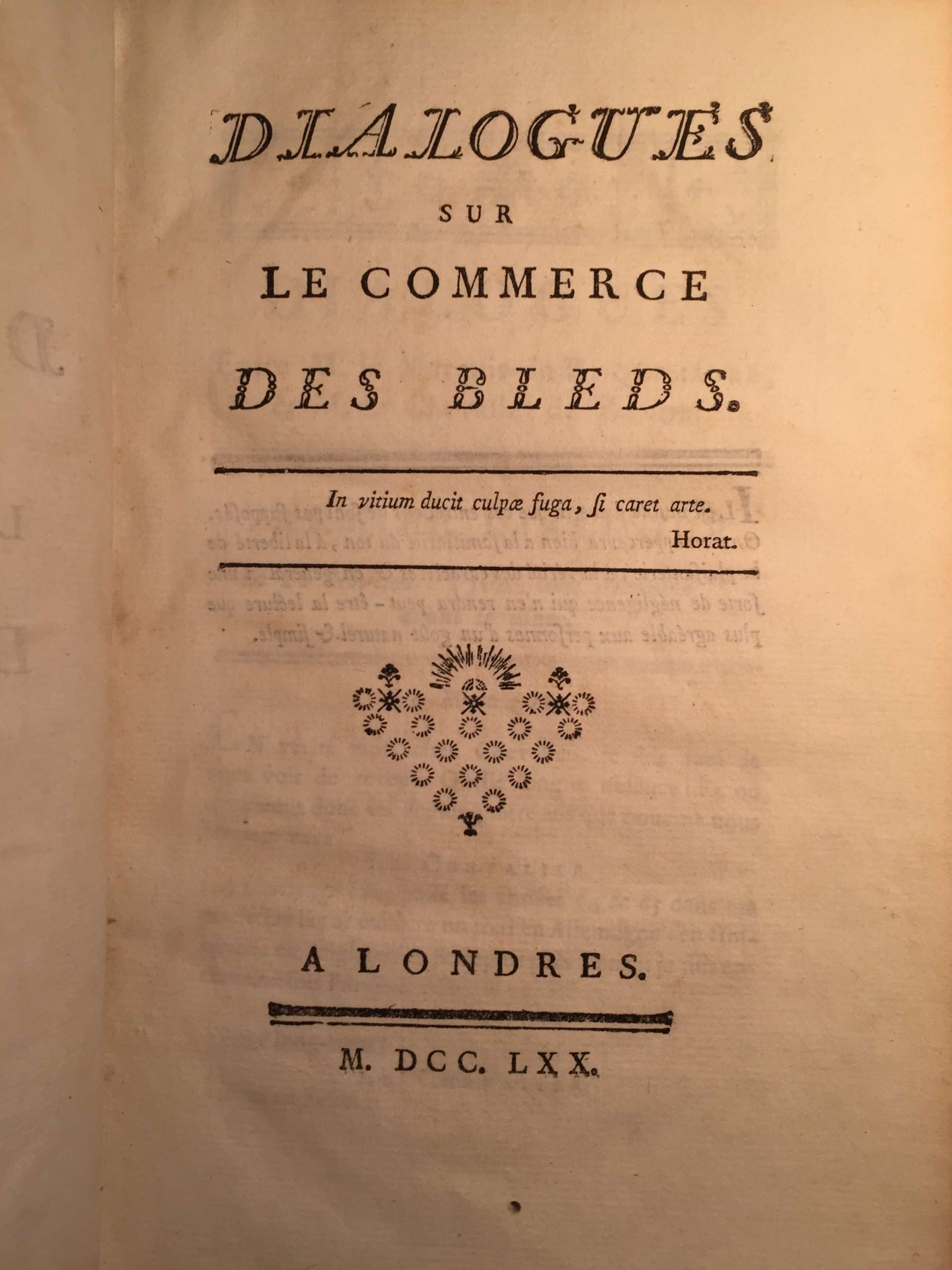
GALIANI, Ferdinando, Abbé. Dialogue sur le commerce des bleds. Londres, 1770. L'Abbé Roubaud, Pierre Joseph André. Récréations économiques ou lettres de l'auteur des représentations aux magistrats, a M. le chevalier Zanobi, principal interlocuteur des Dialogues sur le commerce des bleds; Amsterdam & Paris, Delalain, 1770. Béguillet, Edme. De principiis vegetationis et agreculturae et de causis triplicis culturae in Burgundia disquisitio physica. Auctore E.B.D. ex Societate Œconomica Lugdunensi; Divione, 1768.
-
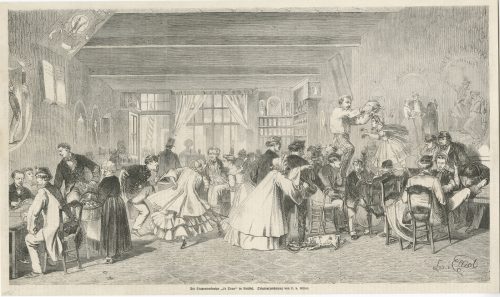
A woodcut illustration after drawing by Leo von Elliot, published at Illustrirte Zeitung, 17 January 1863. English translation: Student bar "The Hole" in Brussels.
The official name of this bar, located at Rue des Sols in Bussels, was "À la vue de l'Université" (In sight of the University). This was the place where the students of the Université libre de Bruxelles (Free University of Brussels), and especially the members of Société, ou Cercle, des Crocodiles (The Crocodile Society, or Circle), gathered in the 1860s. -
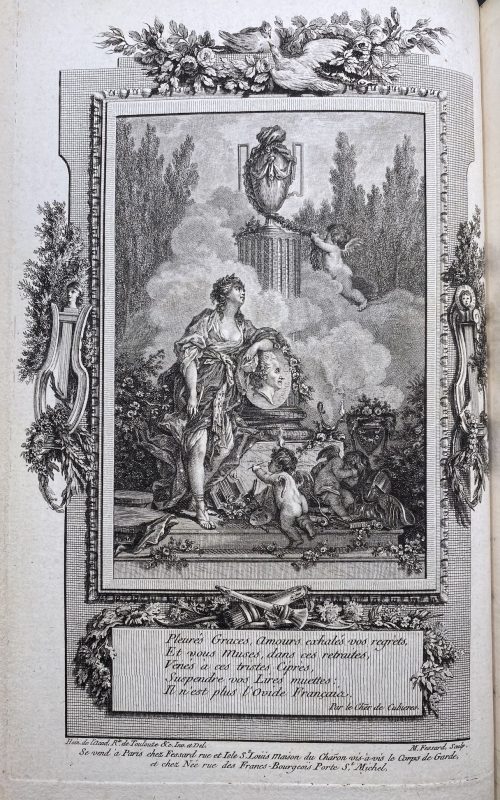 Title page: LES | BAISERS , | PRÉCÉDES | DU MOIS DE MAI, | POËME. | [vignette] | A LA HAYE , | Et se trouve à Paris | Chez Lambert , Imprimeur, rue de la Harpe. | Et Delalain , rue de la Comédie Françoise. | M. DCC. LXX Size: 8vo; 24.5 x 15.5 cm; Binding by Hippolyte Duru – stamp at the back of the front end paper DURU, 1855; full red calf, boards decorated in gilt, raised bands and gilt decorations in compartments, gilt lettering, AEG, peacock marbled end papers, text and illustrations printed on Holland paper. Collation: 2 ffls, engraved half-title by N. Ponce after Ch. Eisen, frontispiece by Etienne Fessard after Claude-Jean-Baptiste Hoin (French, 1750 – 1817) w/guard tissue, t.p. by J. Aliamet after Ch. Eisen, Réflexions préliminaires: A8, B4; 'Le Mois de Mai' half-title, imprim. note on verso, frontispice by De Longueil after Ch. Eisen w/guard tissue, A4 C-F(8) H4; 2bfls. Frontispiece by Etienne Fessard is unique in this edition. Pagination: [2] 3-24, [27]/28, 5/6, 31/32 31/34 11/12 37-119 [120], 22 head-pieces after Ch. Eisen and 22 end-pieces after Marillier, engraved by Baquoy, Binet, Delaunay, Lingée, De Longueil, Masquelier, Massard, and Née. Mistakes in pagination likely confirms first printing first edition. Catalogue raisonné: Cohen, De Ricci (1912): 308-311). Artists: Charles Eisen (French, 1720–1778); Clément Pierre Marillier (French, 1740–1808), and Claude-Jean-Baptiste Hoin (French, 1750–1817). Engravers: Jacques Aliamet (French, 1726–1788); Jean Charles Baquoy (French, 1721–1777); Louis Binet (French, 1744–about 1800); Nicolas Delaunay (French, 1739–1792); Etienne Fessard (French, 1714–1777); Charles Louis Lingée (French, 1748–1819); Joseph de Longueil (French, 1730–1792); Louis Joseph Masquelier (French, 1741–1811); Jean Massard (1740–1822); François Denis Née (French, 1735–1818); Nicholas Ponce (French, 1746–1831).
Title page: LES | BAISERS , | PRÉCÉDES | DU MOIS DE MAI, | POËME. | [vignette] | A LA HAYE , | Et se trouve à Paris | Chez Lambert , Imprimeur, rue de la Harpe. | Et Delalain , rue de la Comédie Françoise. | M. DCC. LXX Size: 8vo; 24.5 x 15.5 cm; Binding by Hippolyte Duru – stamp at the back of the front end paper DURU, 1855; full red calf, boards decorated in gilt, raised bands and gilt decorations in compartments, gilt lettering, AEG, peacock marbled end papers, text and illustrations printed on Holland paper. Collation: 2 ffls, engraved half-title by N. Ponce after Ch. Eisen, frontispiece by Etienne Fessard after Claude-Jean-Baptiste Hoin (French, 1750 – 1817) w/guard tissue, t.p. by J. Aliamet after Ch. Eisen, Réflexions préliminaires: A8, B4; 'Le Mois de Mai' half-title, imprim. note on verso, frontispice by De Longueil after Ch. Eisen w/guard tissue, A4 C-F(8) H4; 2bfls. Frontispiece by Etienne Fessard is unique in this edition. Pagination: [2] 3-24, [27]/28, 5/6, 31/32 31/34 11/12 37-119 [120], 22 head-pieces after Ch. Eisen and 22 end-pieces after Marillier, engraved by Baquoy, Binet, Delaunay, Lingée, De Longueil, Masquelier, Massard, and Née. Mistakes in pagination likely confirms first printing first edition. Catalogue raisonné: Cohen, De Ricci (1912): 308-311). Artists: Charles Eisen (French, 1720–1778); Clément Pierre Marillier (French, 1740–1808), and Claude-Jean-Baptiste Hoin (French, 1750–1817). Engravers: Jacques Aliamet (French, 1726–1788); Jean Charles Baquoy (French, 1721–1777); Louis Binet (French, 1744–about 1800); Nicolas Delaunay (French, 1739–1792); Etienne Fessard (French, 1714–1777); Charles Louis Lingée (French, 1748–1819); Joseph de Longueil (French, 1730–1792); Louis Joseph Masquelier (French, 1741–1811); Jean Massard (1740–1822); François Denis Née (French, 1735–1818); Nicholas Ponce (French, 1746–1831). -
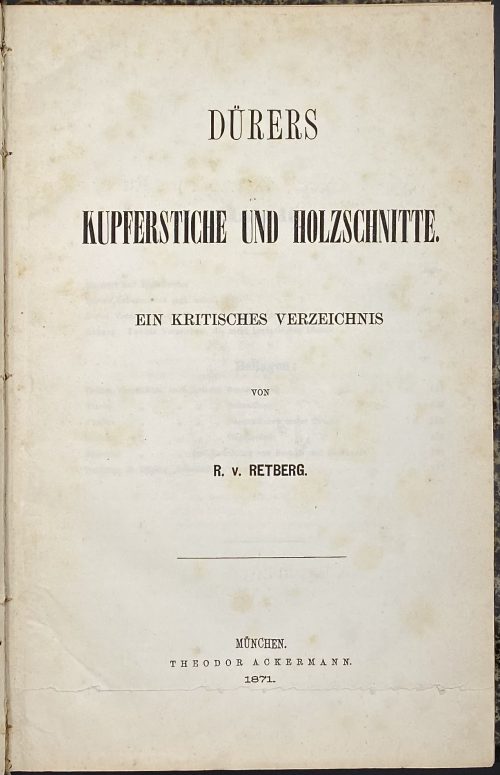 Publisher’s blue wrapper: DÜRERS | KUPFERSTICHE UND HOLZSCHNITTE. | EIN KRITISCHES VERZEICHNIS | VON | R. v. RETBERG. | MÜNCHEN. | THEODOR ACKERMANN. | 1871. || Title page: similar to front wrapper, 2.5 cm cut at the bottom, text not affected. Pagination: front wrapper with lettering in a frame, flyleaf, [4] 1-169 [170 blank] [2], flyleaf, back wrapper with imprint plus 2 plates (frontis., Il. entry №129, and op. p., il. entry 100 № 260, printed on laid paper without watermark). Collation: π2 1-88 9-134 142, plus 2 plates extraneous to collation, incl. frontispiece. Binding: 26.4 x 17.5 cm, quarter green morocco over marbled boards, black compartment fillets and lettering to spine, publisher’s wrappers preserved. Marks: bookplate 6 x 9 cm to front pastedown: “БИБЛИОТЕКА | ГОСУДАРСТВЕННОГО | ЭРМИТАЖА ИЗ СОБРАНИЯ | СТЕПАНА ПЕТРОВИЧА | ЯРЕМИЧА | (1869 – 1939)”, purple ink stamp “В ПРОДАЖУ”. To front wrapper: Ink manuscript on top “Dr. Lichtenstein”… etc., black ink seal of rampant lion and pencil number “949” in the middle; pencil marks to p. 162.
Publisher’s blue wrapper: DÜRERS | KUPFERSTICHE UND HOLZSCHNITTE. | EIN KRITISCHES VERZEICHNIS | VON | R. v. RETBERG. | MÜNCHEN. | THEODOR ACKERMANN. | 1871. || Title page: similar to front wrapper, 2.5 cm cut at the bottom, text not affected. Pagination: front wrapper with lettering in a frame, flyleaf, [4] 1-169 [170 blank] [2], flyleaf, back wrapper with imprint plus 2 plates (frontis., Il. entry №129, and op. p., il. entry 100 № 260, printed on laid paper without watermark). Collation: π2 1-88 9-134 142, plus 2 plates extraneous to collation, incl. frontispiece. Binding: 26.4 x 17.5 cm, quarter green morocco over marbled boards, black compartment fillets and lettering to spine, publisher’s wrappers preserved. Marks: bookplate 6 x 9 cm to front pastedown: “БИБЛИОТЕКА | ГОСУДАРСТВЕННОГО | ЭРМИТАЖА ИЗ СОБРАНИЯ | СТЕПАНА ПЕТРОВИЧА | ЯРЕМИЧА | (1869 – 1939)”, purple ink stamp “В ПРОДАЖУ”. To front wrapper: Ink manuscript on top “Dr. Lichtenstein”… etc., black ink seal of rampant lion and pencil number “949” in the middle; pencil marks to p. 162.Contents: Inhalt - Berichtigungen - Vorwort und Einleitendes - Dürers Lebenskizze - [Text] - Nachtrag zu Dürers "Lebenskizze". A critical directory of Albrecht Dürer (German, 1471 – 1528) copperplate engravings and woodcuts by Ralf von Retberg (German, 1812 – 1885): the description of 167 woodcuts and 103 copperplate engravings.
Provenance: From the collection of a Russian artist Stepan Petrovich Yaremich, sold by Hermitage Museum in St. Petersburg. Ref: Royal Academy. -
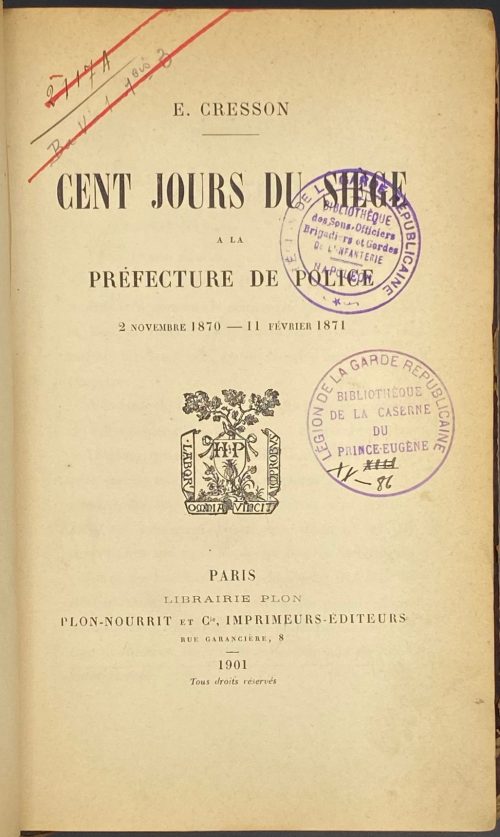 Title-page: E. CRESSON |—| CENT JOURS DE SIÈGE | A LA | PRÉFECTURE DE POLICE | 2 NOVEMBRE 1870 — 11 FÉVRIER 1871 | {publisher’s device} | PARIS | LIBRAIRIE PLON | PLON-NOURRIT ET Cie, IMPRIMEURS-ÉDITEURS | RUE GARANCIÈRE, 8 | 1901 | Tous droits réservés || Description: 8vo, 22 x 14.5 cm, quarter brown calf over marbled boards, flat spine with gilt fillets, gilt lettering, marbled endpapers; inscriptions to t.p.: 2117 A | Ba V –1 1bis 3; ink stamps to t.p.: (1) « LÉGION DE LA GARDE REPUBLICAINE | BIBLIOTÈQUE | des Sous-Officiers | Brigadiers et Gardes | DE L’INFANTERIA | NAPOLEON » ; (2) « LÉGION DE LA GARDE REPUBLICAINE | BIBLIOTÈQUE | DE LA CASERNE | DU | PRINCE-EUGÈNE | (hand) XIII | XX—86 » Collation: 8vo; π6 1-248 252, total 200 leaves. Pagination: [2] [i-v] vi-x, [1] 2-385 [3], total 400 pages. BNF: ark:/12148/bpt6k4936n Author: Ernest Cresson (French, 1824 – 1902)
Title-page: E. CRESSON |—| CENT JOURS DE SIÈGE | A LA | PRÉFECTURE DE POLICE | 2 NOVEMBRE 1870 — 11 FÉVRIER 1871 | {publisher’s device} | PARIS | LIBRAIRIE PLON | PLON-NOURRIT ET Cie, IMPRIMEURS-ÉDITEURS | RUE GARANCIÈRE, 8 | 1901 | Tous droits réservés || Description: 8vo, 22 x 14.5 cm, quarter brown calf over marbled boards, flat spine with gilt fillets, gilt lettering, marbled endpapers; inscriptions to t.p.: 2117 A | Ba V –1 1bis 3; ink stamps to t.p.: (1) « LÉGION DE LA GARDE REPUBLICAINE | BIBLIOTÈQUE | des Sous-Officiers | Brigadiers et Gardes | DE L’INFANTERIA | NAPOLEON » ; (2) « LÉGION DE LA GARDE REPUBLICAINE | BIBLIOTÈQUE | DE LA CASERNE | DU | PRINCE-EUGÈNE | (hand) XIII | XX—86 » Collation: 8vo; π6 1-248 252, total 200 leaves. Pagination: [2] [i-v] vi-x, [1] 2-385 [3], total 400 pages. BNF: ark:/12148/bpt6k4936n Author: Ernest Cresson (French, 1824 – 1902) -
![E. de Crauzat. L'Œuvre gravé et lithographié de Steinlen: Catalogue descriptif et analytique suivi d'un essai de bibliographie et d'Iconographie de son œuvre illustré / Préface de Roger Marx. — San Francisco: Alan Wofsy Fine Arts, 1983. — Fac similé de l'édition originale de 1913. — pp.: [i-ix] x-xv [1-3] 4-228 [229-234]. — [Ernest de Crauzat].](https://varshavskycollection.com/wp-content/uploads/2021/02/LIB-2289.2019-d-500x707.jpeg) Title: DE CRAUZAT | L'ŒUVRE | Gravé et Lithographié | DE | STEINLEN | Catalogue descriptif et analytique | suivi d'un essai de bibliographie et d'Iconographie | de son œuvre illustré. | PRÉFACE | DE ROGER MARX | San Francisco | Alan Wofsy Fine Arts | 1983. Edition: Fac-similé de l'édition originale de 1913. Pagination: [i-ix] x-xv [1-3] 4-228 [229-234]. Size: 32 x 24 cm.
Title: DE CRAUZAT | L'ŒUVRE | Gravé et Lithographié | DE | STEINLEN | Catalogue descriptif et analytique | suivi d'un essai de bibliographie et d'Iconographie | de son œuvre illustré. | PRÉFACE | DE ROGER MARX | San Francisco | Alan Wofsy Fine Arts | 1983. Edition: Fac-similé de l'édition originale de 1913. Pagination: [i-ix] x-xv [1-3] 4-228 [229-234]. Size: 32 x 24 cm. -
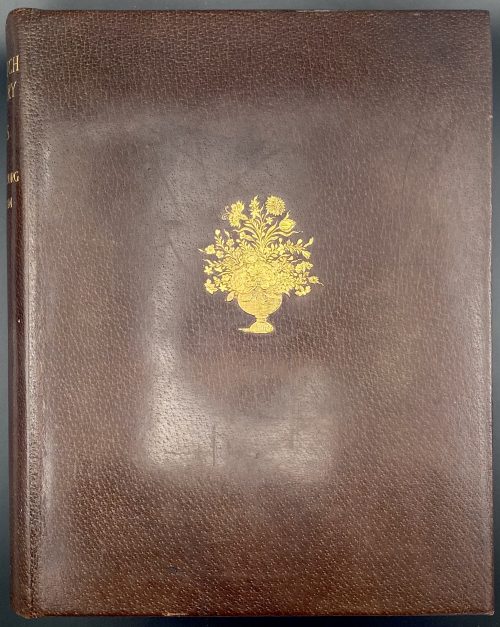 Title: OLD DUTCH | POTTERY AND TILES | BY ELISABETH | NEURDENBURG | LITT. D., READER IN THE HISTORY OF ART AT | THE UNIVERSITY OF GRONINGEN. TRANSLATED | WITH ANNOTATIONS BY | Bernard Rackham | DEPUTY KEEPER, DEPARTMENT | OF CERAMICS, VICTORIA AND | ALBERT MUSEUM | […] | WITH ONE HUNDRED AND TWELVE | ILLUSTRATIONS OF WHICH NINE | ARE IN COLOUR | LONDON: BENN BROTHERS, LIMITED | 8 BOUVERIE STREET, E.C. 4 | 1923 || Verso to half-title: Of this book 100 copies only for sale have been printed on English | hand-made paper, bound in pigskin and signed by the Authoress | and Translator. These copies also contain an extra colour plate. | This in Number “7” (in manuscript) | Two signatures (ink, manuscript) || Pagination: [i, ii] – h.t. / tirage, [iii, iv] – t.p. / imprint, [v, vi] – dedication to Dr. A. Pit / blank, vii-xv [xvi blank] [1, 2] 3-155 [156 blank], frontispiece (colour) and 59 leaves of plates (9 colour) with 112 figures, with lettered protective sheets. Collation: 4to in 8th; [A]8 [B]8 C-K8 L6; frontis., +59 leaves of plates. Binding: 30 x 24 cm, Full dark brown pigskin with gilt ornament to front board and gilt lettering to spine; printed on thick wove paper, top edge gilt, others untrimmed. Contributors: Neurdenburg, Elisabeth (Dutch, 1882 – 1957) – author [autograph]. Rackham, Bernard (British, 1876 – 1964) – translator [autograph]. Brendon, William (British, 1845 – 1928) – printer. Mayflower Press (Plymouth), William Brendon & Son, Ltd. – printer Benn Brothers Ltd. (British company, 1880 – 1987) Benn, Sir John, 1st Baronet (British, 1850 – 1922)
Title: OLD DUTCH | POTTERY AND TILES | BY ELISABETH | NEURDENBURG | LITT. D., READER IN THE HISTORY OF ART AT | THE UNIVERSITY OF GRONINGEN. TRANSLATED | WITH ANNOTATIONS BY | Bernard Rackham | DEPUTY KEEPER, DEPARTMENT | OF CERAMICS, VICTORIA AND | ALBERT MUSEUM | […] | WITH ONE HUNDRED AND TWELVE | ILLUSTRATIONS OF WHICH NINE | ARE IN COLOUR | LONDON: BENN BROTHERS, LIMITED | 8 BOUVERIE STREET, E.C. 4 | 1923 || Verso to half-title: Of this book 100 copies only for sale have been printed on English | hand-made paper, bound in pigskin and signed by the Authoress | and Translator. These copies also contain an extra colour plate. | This in Number “7” (in manuscript) | Two signatures (ink, manuscript) || Pagination: [i, ii] – h.t. / tirage, [iii, iv] – t.p. / imprint, [v, vi] – dedication to Dr. A. Pit / blank, vii-xv [xvi blank] [1, 2] 3-155 [156 blank], frontispiece (colour) and 59 leaves of plates (9 colour) with 112 figures, with lettered protective sheets. Collation: 4to in 8th; [A]8 [B]8 C-K8 L6; frontis., +59 leaves of plates. Binding: 30 x 24 cm, Full dark brown pigskin with gilt ornament to front board and gilt lettering to spine; printed on thick wove paper, top edge gilt, others untrimmed. Contributors: Neurdenburg, Elisabeth (Dutch, 1882 – 1957) – author [autograph]. Rackham, Bernard (British, 1876 – 1964) – translator [autograph]. Brendon, William (British, 1845 – 1928) – printer. Mayflower Press (Plymouth), William Brendon & Son, Ltd. – printer Benn Brothers Ltd. (British company, 1880 – 1987) Benn, Sir John, 1st Baronet (British, 1850 – 1922) -
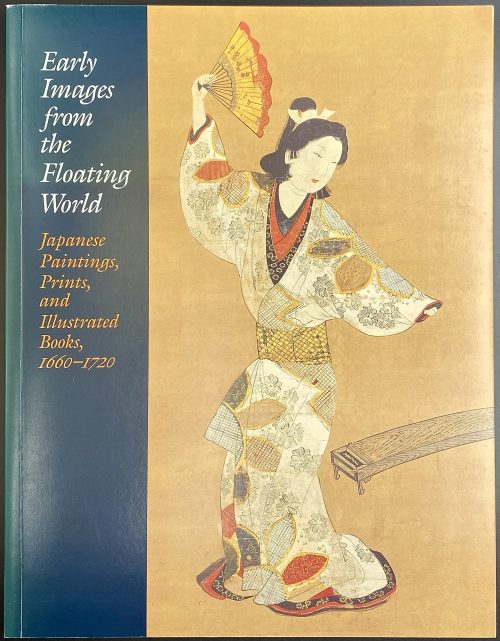 Softcover, in pictorial wrappers, 28 x 21.8 cm, 37 entries, with colour illustrations. Catalogue of the sales exhibition on March 3 - April 5, 2008 in NY; pagination: [1-3] 4-102 [2], ils. Contributor: Sebastian Izzard
Softcover, in pictorial wrappers, 28 x 21.8 cm, 37 entries, with colour illustrations. Catalogue of the sales exhibition on March 3 - April 5, 2008 in NY; pagination: [1-3] 4-102 [2], ils. Contributor: Sebastian Izzard -
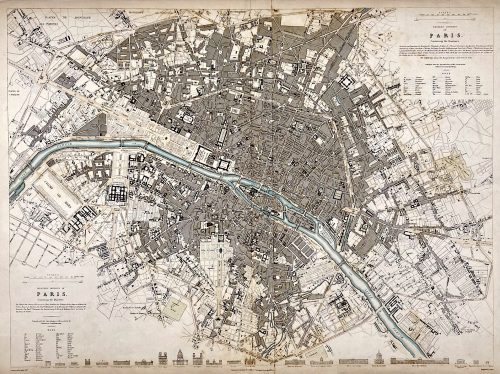 Top right: EASTERN DIVISION OF | PARIS. | Containing the Quartiers | {5 lines in italic} | Published under the Superintendence of the Society for the | Diffusion of Useful Knowledge || Bottom left: WESTERN DIVISION OF | PARIS. | Containing the Quartiers | {4 lines in italic} | Published under the Superintendence of the Society for the | Diffusion of Useful Knowledge || Under the frame: Drawn by W. B. Clarke, Archt. […] Published by Baldwin & Cradock, 47 Paternoster Row, A April 1st, 1834. [...] Engraved by J. Shury || Dimensions: Sheet: 40.8 x 57 cm; Image: 38.7 x 52.5 cm. Contributors: William Barnard Clarke (British, 1806 – 1865) – artist. John Shury (fl. c. 1814-1844) – engraver. Baldwin & Cradock (London) – publisher. Society for the Diffusion of Useful Knowledge (SDUK) (British firm, 1826 – 1846).
Top right: EASTERN DIVISION OF | PARIS. | Containing the Quartiers | {5 lines in italic} | Published under the Superintendence of the Society for the | Diffusion of Useful Knowledge || Bottom left: WESTERN DIVISION OF | PARIS. | Containing the Quartiers | {4 lines in italic} | Published under the Superintendence of the Society for the | Diffusion of Useful Knowledge || Under the frame: Drawn by W. B. Clarke, Archt. […] Published by Baldwin & Cradock, 47 Paternoster Row, A April 1st, 1834. [...] Engraved by J. Shury || Dimensions: Sheet: 40.8 x 57 cm; Image: 38.7 x 52.5 cm. Contributors: William Barnard Clarke (British, 1806 – 1865) – artist. John Shury (fl. c. 1814-1844) – engraver. Baldwin & Cradock (London) – publisher. Society for the Diffusion of Useful Knowledge (SDUK) (British firm, 1826 – 1846). -
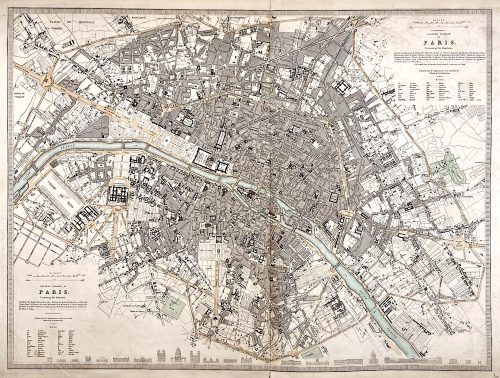 Top right: EASTERN DIVISION OF | PARIS. | Containing the Quartiers | {5 lines in italic} | Published under the Superintendence of the Society for the | Diffusion of Useful Knowledge || Bottom left: WESTERN DIVISION OF | PARIS. | Containing the Quartiers | {4 lines in italic} | Published under the Superintendence of the Society for the | Diffusion of Useful Knowledge || The map is framed, but there is no lettering beneath the frame to identify the cartographer, engraver, and publisher. However, we can attribute it to William Barnard Clarke (British, 1806 – 1865) and John Shury (fl. c. 1814-1844). The publisher is either Baldwin & Cradock or Chapman and Hall. Dimensions: Sheet: 40 x 60.8 cm; Image: 40 x 53.5 cm.
Top right: EASTERN DIVISION OF | PARIS. | Containing the Quartiers | {5 lines in italic} | Published under the Superintendence of the Society for the | Diffusion of Useful Knowledge || Bottom left: WESTERN DIVISION OF | PARIS. | Containing the Quartiers | {4 lines in italic} | Published under the Superintendence of the Society for the | Diffusion of Useful Knowledge || The map is framed, but there is no lettering beneath the frame to identify the cartographer, engraver, and publisher. However, we can attribute it to William Barnard Clarke (British, 1806 – 1865) and John Shury (fl. c. 1814-1844). The publisher is either Baldwin & Cradock or Chapman and Hall. Dimensions: Sheet: 40 x 60.8 cm; Image: 40 x 53.5 cm. -
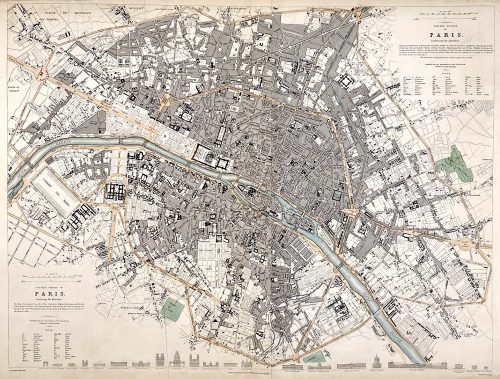 Top right: EASTERN DIVISION OF | PARIS. | Containing the Quartiers | {5 lines in italic} | Published under the Superintendence of the Society for the | Diffusion of Useful Knowledge || Bottom left: WESTERN DIVISION OF | PARIS. | Containing the Quartiers | {4 lines in italic} | Published under the Superintendence of the Society for the | Diffusion of Useful Knowledge || Under the frame: Drawn by W. B. Clarke, Archt. […] London: Published by Chapman and Hall, 186, Strand. April 1st, 1834. [...] Engraved by J. Shury || Dimensions: Sheet: 40.8 x 57 cm; Image: 38.7 x 52.5 cm. Contributors: William Barnard Clarke (British, 1806 – 1865) – artist. John Shury (fl. c. 1814-1844) – engraver. Chapman and Hall (London) – publisher. Society for the Diffusion of Useful Knowledge (SDUK) (British firm, 1826 – 1846).
Top right: EASTERN DIVISION OF | PARIS. | Containing the Quartiers | {5 lines in italic} | Published under the Superintendence of the Society for the | Diffusion of Useful Knowledge || Bottom left: WESTERN DIVISION OF | PARIS. | Containing the Quartiers | {4 lines in italic} | Published under the Superintendence of the Society for the | Diffusion of Useful Knowledge || Under the frame: Drawn by W. B. Clarke, Archt. […] London: Published by Chapman and Hall, 186, Strand. April 1st, 1834. [...] Engraved by J. Shury || Dimensions: Sheet: 40.8 x 57 cm; Image: 38.7 x 52.5 cm. Contributors: William Barnard Clarke (British, 1806 – 1865) – artist. John Shury (fl. c. 1814-1844) – engraver. Chapman and Hall (London) – publisher. Society for the Diffusion of Useful Knowledge (SDUK) (British firm, 1826 – 1846). -
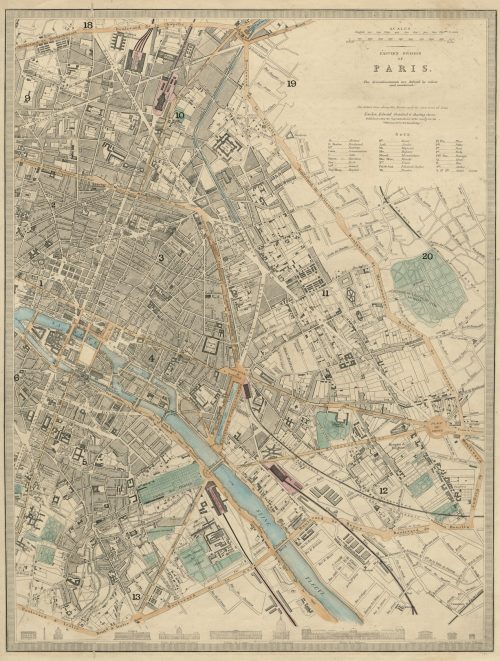 EASTERN DIVISION | OF | PARIS. | The Arrondissements are defined by colour | and numbered. || London, Edward Stanford 6 Charing Cross. | Published under the Superintendence of the Society for the Diffusion of Useful Knowledge. || Dimensions: Sheet: 43.5 x 35.5 cm; Image: 39.5 x 30 cm. Contributors: Edward Stanford (British, 1827 – 1904) – cartographer, engraver, publisher. Society for the Diffusion of Useful Knowledge (SDUK) (British firm, 1826 – 1846).
EASTERN DIVISION | OF | PARIS. | The Arrondissements are defined by colour | and numbered. || London, Edward Stanford 6 Charing Cross. | Published under the Superintendence of the Society for the Diffusion of Useful Knowledge. || Dimensions: Sheet: 43.5 x 35.5 cm; Image: 39.5 x 30 cm. Contributors: Edward Stanford (British, 1827 – 1904) – cartographer, engraver, publisher. Society for the Diffusion of Useful Knowledge (SDUK) (British firm, 1826 – 1846). -
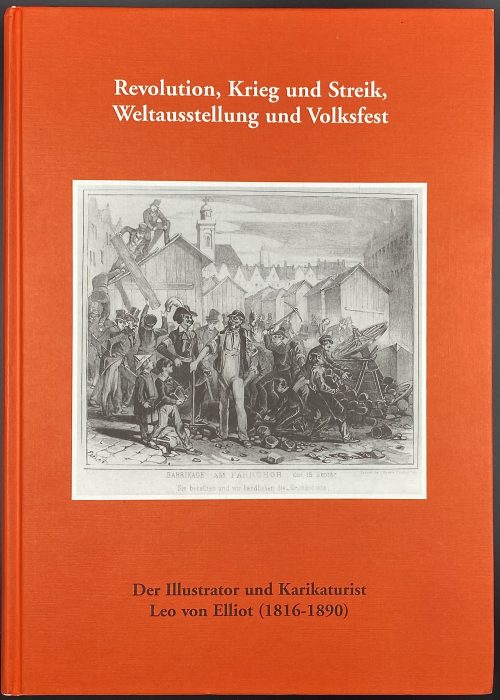 Title: Revolution, Krieg und Streik, | Weltausstellung und Volksfest | Der Illustrator und Karikaturist | Leo von Elliot (1816–1890) | von Eckhart G. Franz | Hessische Historische Kommission Darmstadt 2000 || Series: Arbeiten der Hessischen Historischen Kommission, Neue Folge Band 17. Pagination: [1-6] 7-340, 458 b/w illustration. Binding: hardcover, red pictorial boards, 30 x 21.5 cm.
Title: Revolution, Krieg und Streik, | Weltausstellung und Volksfest | Der Illustrator und Karikaturist | Leo von Elliot (1816–1890) | von Eckhart G. Franz | Hessische Historische Kommission Darmstadt 2000 || Series: Arbeiten der Hessischen Historischen Kommission, Neue Folge Band 17. Pagination: [1-6] 7-340, 458 b/w illustration. Binding: hardcover, red pictorial boards, 30 x 21.5 cm. -
 Magazine article by Edgar Jepson: The Iron Tsuba of Japan (Section: Oriental Art), published in volume Vol. 70 (September–December) of The Connoisseur: An Illustrated Magazine for Collectors, Vol. 70 (September–December); pp. 143-152 / C. Reginald Grundy [ed.] — London: Published by the Proprietor, W. CLAUSE JOHNSON, at the Editorial and Advertisement Offices of The Connoisseur, 1924. Owner's half black morocco, gilt lettering to spine, blue cloth boards. Two volumes bound together without original covers. Size 28.5 x 22 cm. Vol. 1: The Connoisseur | An Illustrated Magazine | For Collectors | Edited by C. Reginald Grundy | Vol. LXIX. | (MAY—AUGUST, 1924) | LONDON | Published by the Proprietor, W. CLAUSE JOHNSON, at the | Editorial and Advertisement Offices of The Connoisseur, | at 1, Duke Street, St. James's, S.W. 1 | 1924 || Pp.: [i-ii] iii-xviii [xix] [1, 2 - plate] 3-249 [250]. Vol. 2: The Connoisseur | An Illustrated Magazine | For Collectors | Edited by C. Reginald Grundy | Vol. LXX. | (SEPTEMBER—DECEMBER, 1924) | LONDON | Published by the Proprietor, W. CLAUSE JOHNSON, at the | Editorial and Advertisement Offices of The Connoisseur, | at 1, Duke Street, St. James's, S.W. 1 | 1924 || Pp.: [i-ii] iii-xxii [2 blanks] [1, 2 - plate] 3-261 [262]. The Iron Tsuba of Japan by Edgar Jepson The heart of Japan was in the sword. However admirable may be the paintings, the prints, the netsuke, the lacquer, or the bronzes of the Japanese masters, the supreme artistic achievements of Japan were the blades of Masamune, Muramasa, Sadamune, and Rai Kunitsugu. But not a little of the heart of Japan went also in the tsuba, the guard which protected the hand that wielded the blade, into the iron tsuba of the fighting Samurai. Beside the forgers of the iron tsuba of Japan the ironsmiths of the rest of the world have been mere children. The earliest tsuba were of bronze or copper, often gilded. It is probable that they were replaced by iron tsuba during the Kamakura period, the great fighting era, which lasted from A.D. 1185 to 1333. During the later half of the twelfth century leather tsuba, strengthened by thin iron plates or a metal rim, also replaced the bronze and copper tsuba. It was at this time that a family of armourers of the name of Masuda, and in particular Masuda Munesuke, the founder of the Myochin family, began to forge iron tsuba — thin, round plates of great hardness and density. But it is probable that no tsuba perforated with a view to decorative effects were forged before the end of the fourteenth century. These fourteenth-century tsuba are exceedingly rare in England. I have seen none in the museums, none in the famous collections that have been sold during the last ten years. Those photographed in Herr Oeder's book might easily be the fifteenth century. No. 1 is a curious cup-shape tsuba decorated with a bronze and copper inlay. No. 2, with its edges curiously twisted in the forging, looks like Myochin work. But it is not of the Myochin iron. The Myochin family produced some of the greatest ironsmiths of Japan. Armourers first of all, tsubasmiths, forgers of sake-kettles, articulated reptiles, crustacea, and insects — everything that can be done with iron they did; they pushed their medium to its limit. They were forging iron tsuba in 1160, and they were still forging them in 1860. And it was their own iron, or rather their own steel. They discovered the secret of it early, and they kept that secret in the family for all those hundreds of years. There is no mistaking a Myochin tsuba: balance it on your finger and tap it with a piece of metal, always it gives forth a clear bell-like ring that you get from the work of no other ironsmith, Japanese or European. Always the Myochin tsuba is before everything a protection to the hand of the swordsman; to that everything is, as it should be, subordinated. No. 3 is a Myochin tsuba of the fifteenth century, and probably of the early fifteenth century. No. 4, by Myochin Munetaka, perforated with a grotesque figure, is an example of that twisting and twisting of the iron in the forging till it forms a pattern like the grain of wood. The Myochin smiths invented these wood-grain tsuba, and no other smiths equalled them in their forging. In the sixteenth century, the fighting tsuba was probably at its best. It was a century of great tsubasmiths. Then the first Nobuiye, whose tsuba fetched £100 apiece, circa 1800, in Japan, and the first Kaneiye flourished. No. 5 is a tsuba forged by a great smith, Iyesada of Sotome, in the manner of Nobuiye I, decorated with the karakusa tendrils that Nobuiye delighted in, with lightning and clouds. No. 6 is a guard of Sanada Tembo, the chief smith of the Tembo family, stamped, punning fashion, with the character Tembo. Akin to the Tembo tsuba were those of the Kiami and Hoan smiths. Then also the Heianjo smiths and the Owari smiths, especially those of Nagoya and the Yamakichi family, forged their strongest tsuba. Those of the Yamakichi were tested after the forging by being pounded in iron mortars — at least, so the legend runs. But they were a sternly utilitarian family, and I have never seen a Yamakichi tsuba of any beauty. In the later half of the fifteenth century arose the fashion of decorating tsuba with an inlay, zogan, of bronze. The Heianjo tsuba, forged at Kyoto in the latter half of the fifteenth and the beginning of the sixteenth century, were often thus inlaid. The earliest of them were called "Onin", of which No. 7 is an example. In addition to the bronze inlay around the edge, it is inlaid with a representation, some say, of snow; others say, of the duckweed on a pond. No. 8 is probably a Heianjo tsuba, but I am not quite sure about it. The inlaid acacia branches might be very early Shoami work. But to judge by the iron, it is a fifteenth-century tsuba; and the authorities place the beginning of the Shoami school not later than early in the sixteenth century. No. 10 is an example of the Fushimi-zogan, a flat inlay of a light-coloured bronze. These tsuba took their name from the fact that they were first forged at Fushimi, in Yamashiro, in the sixteenth century. It is of the type known as Mon-zukashi, perforated with crests (mon) à jour. The Yoshiro-zogan tsuba were also first forged at Fushimi by Yoshiro Naomasa. They were distinguished from the Fushimi-zogan by the fact that their inlay was generally a little raised-not always-for the inlay of No. 9, a tsuba forged by a later nineteenth-century Yoshiro, is quite flat. It is an interesting tsuba, for, with its decoration grown florid and excessive, it marks the intermediate stage between the simple and delightful designs of the genuine fighting tsuba and the elaborate pictures in gold and silver on the tsuba of the eighteenth-century smiths of Awa and Kyoto, which have become mere ornaments of the goldsmith. The Gomoku-zogan (No. 11) tsuba were probably first forged earlier than the Fushimi and Yoshiro-zogan tsuba. This inlay, in slight relief, is a representation in a light-coloured bronze and copper of twigs caught in the eddies of streams. The seventeenth century and early eighteenth century were the great periods of perforated tsuba. The designs, and they are often admirable, are for the most part in plain fretwork; but they are also chased. No. 12, a crane under an acacia, is a tsuba of a Higo smith, great forgers of fighting tsuba during this period. These smiths also excelled in nunome zogan, a very thin gold and silver inlay, with which they further decorated their perforated guards. The smiths of the Umetada and Shoami families also forged iron tsuba during this period; but their designs, though sometimes pleasing enough, are rarely fine. The best work of Myoju Umetada is in sentoku, not iron. The Choshu smiths, coming later, surpass the perforated guards of both the Umetada and Shoami smiths in beauty of design. No. 13, a lotus in the round, not only fretwork, but also engraved, is a good example of the admirable balance they so often attained in their designs. It is a sufficiently realistic lotus, but yet of a delightful simplicity. In considerable contrast is No. 14, the dragon by Soheishi Soten — one of the only two authentic tsuba of his forging known — the first forger of hikone-bori tsuba, which were in extraordinary favour in Japan during the eighteenth century, and illustrated every important event in Japanese history. It is on the elaborate side, but fine, strong work, and an excellent guard to the hand, for the lighter and more open part, which gives the design its admirable balance, is on the inside, and not exposed to the full swing of an opponent's blade. A few years ago there was a tendency to decry the Namban tsuba as having sprung too directly from foreign sources. But though the original suggestion may have been Chinese, or, as some say, Portuguese, the Japanese made it entirely their own, as characteristically Japanese as anything can well be, but, it must be admitted, of a decadent period. The school took its rise at the beginning of the seventeenth century, and the early tsuba were forged of a specially hard iron, the Wootz, imported from Southern India. No. 15, the signs of the Zodiac, is an excellent tsuba from the fighting point of view. Both it and No. 16 are of quite charming, if elaborate, design, and both of them, with their delicate scroll-work, so astonishingly undercut, are the very last word in the work of the ironsmith-veritable iron lace. To return to the simpler perforated tsuba, the smiths of Akasaka, a suburb of Tokyo, produced probably the most charming designs. Their style derives considerably from the Higo smiths, and their earlier fighting tsuba are very like the Higo tsuba. But always their work was just a little lighter than that of the Higo smiths, and in the end they moved right away from them and became the forgers of very light guards indeed. No. 17, is a representation of the Hiyokudori, the fabulous double bird, in which were reincarnated the souls of the two lovers, Gompachi and Komurasaki; and No. 18, “the tsuba of a hundred ducks "— there are about forty — are characteristic designs of the school. In the work of the Akasaka smiths the balance, which makes the design of a good tsuba so admirable and delightful, attains its height. This admirable balance seems often to be obtained by a deliberate sacrifice of symmetry. About nine hundred and ninety-nine European ironsmiths out of a thousand would have made the right and left sides of the Hiyoku-dori line by line, and perforation by perforation, exactly alike; he would have cut out exactly as many ducks on the one side of “the tsuba of a hundred ducks” as on the other, and made each duck on the right side correspond exactly in position and attitude with a duck on the left side. By variations the tsubasmith attained a finer balance, almost a higher symmetry. No. 19, often called by collectors the "rose-window" tsuba, but really a stylised chrysanthemum, is a favourite design of the Akasaka smiths, but Hizen work and inlaid in the Hizen manner with gold nunome. No. 20 is a Satsuma tsuba of the middle period. The Satsuma smiths of the nineteenth century produced probably the most ornate of all the iron guards, for the most part calibashes and beans with their leaves and tendrils realistic in the extreme, but of charming design. Few crafts have been carried further than that of the tsubasmith; few crafts working in a difficult medium have handled more subjects with greater feeling for beauty or greater liveliness of fancy. It is interesting to note again and again how school influences school, and smith influences smith. But, as in all the applied arts, the finest tsuba were forged by men who never lost sight of the purpose of a tsuba, that it is before everything a protection to the hand, and never subjected that purpose to a passion for virtuosity. Illustrations: No 1. FOURTEENTH-CENTURY TSUBA, WITH BRONZE AND COPPER INLAY No. 2. FOURTEENTH-CENTURY TSUBA, RESEMBLING MYOCHIN WORK No. 3. MYOCHIN TSUBA, FIFTEENTH CENTURY No. 4. MYOCHIN TSUBA, NINETEENTH CENTURY No. 5. SIXTEENTH-CENTURY TSUBA No. 6. SIXTEENTH-CENTURY TSUBA BY IYESADA OF SOTOME BY SANADA TEMBO No. 7. ONIN TSUBA No. 8. HEIANJO (?) TSUBA No. 9. YOSHIRO TSUBA, NINETEENTH CENTURY No. 10. FUSHIMI-ZOGAN, NINETEENTH CENTURY No. 11.- GOMOKU-ZOGAN, SIXTEENTH CENTURY No. 12. HIGO TSUBA, SEVENTEENTH CENTURY No. 13. CHOSHU TSUBA, SEVENTEENTH CENTURY No. 14. SOTEN TSUBA, SEVENTEENTH CENTURY No. 15. NAMBAN TSUBA, EIGHTEENTH CENTURY No. 16. NAMBAN TSUBA, NINETEENTH CENTURY Nos. 17. AND 18. AKASAKA TSUBA, EIGHTEENTH CENTURY No. 19. HIZEN TSUBA, EIGHTEENTH CENTURY No. 20. SATSUMA TSUBA, EIGHTEENTH CENTURY
Magazine article by Edgar Jepson: The Iron Tsuba of Japan (Section: Oriental Art), published in volume Vol. 70 (September–December) of The Connoisseur: An Illustrated Magazine for Collectors, Vol. 70 (September–December); pp. 143-152 / C. Reginald Grundy [ed.] — London: Published by the Proprietor, W. CLAUSE JOHNSON, at the Editorial and Advertisement Offices of The Connoisseur, 1924. Owner's half black morocco, gilt lettering to spine, blue cloth boards. Two volumes bound together without original covers. Size 28.5 x 22 cm. Vol. 1: The Connoisseur | An Illustrated Magazine | For Collectors | Edited by C. Reginald Grundy | Vol. LXIX. | (MAY—AUGUST, 1924) | LONDON | Published by the Proprietor, W. CLAUSE JOHNSON, at the | Editorial and Advertisement Offices of The Connoisseur, | at 1, Duke Street, St. James's, S.W. 1 | 1924 || Pp.: [i-ii] iii-xviii [xix] [1, 2 - plate] 3-249 [250]. Vol. 2: The Connoisseur | An Illustrated Magazine | For Collectors | Edited by C. Reginald Grundy | Vol. LXX. | (SEPTEMBER—DECEMBER, 1924) | LONDON | Published by the Proprietor, W. CLAUSE JOHNSON, at the | Editorial and Advertisement Offices of The Connoisseur, | at 1, Duke Street, St. James's, S.W. 1 | 1924 || Pp.: [i-ii] iii-xxii [2 blanks] [1, 2 - plate] 3-261 [262]. The Iron Tsuba of Japan by Edgar Jepson The heart of Japan was in the sword. However admirable may be the paintings, the prints, the netsuke, the lacquer, or the bronzes of the Japanese masters, the supreme artistic achievements of Japan were the blades of Masamune, Muramasa, Sadamune, and Rai Kunitsugu. But not a little of the heart of Japan went also in the tsuba, the guard which protected the hand that wielded the blade, into the iron tsuba of the fighting Samurai. Beside the forgers of the iron tsuba of Japan the ironsmiths of the rest of the world have been mere children. The earliest tsuba were of bronze or copper, often gilded. It is probable that they were replaced by iron tsuba during the Kamakura period, the great fighting era, which lasted from A.D. 1185 to 1333. During the later half of the twelfth century leather tsuba, strengthened by thin iron plates or a metal rim, also replaced the bronze and copper tsuba. It was at this time that a family of armourers of the name of Masuda, and in particular Masuda Munesuke, the founder of the Myochin family, began to forge iron tsuba — thin, round plates of great hardness and density. But it is probable that no tsuba perforated with a view to decorative effects were forged before the end of the fourteenth century. These fourteenth-century tsuba are exceedingly rare in England. I have seen none in the museums, none in the famous collections that have been sold during the last ten years. Those photographed in Herr Oeder's book might easily be the fifteenth century. No. 1 is a curious cup-shape tsuba decorated with a bronze and copper inlay. No. 2, with its edges curiously twisted in the forging, looks like Myochin work. But it is not of the Myochin iron. The Myochin family produced some of the greatest ironsmiths of Japan. Armourers first of all, tsubasmiths, forgers of sake-kettles, articulated reptiles, crustacea, and insects — everything that can be done with iron they did; they pushed their medium to its limit. They were forging iron tsuba in 1160, and they were still forging them in 1860. And it was their own iron, or rather their own steel. They discovered the secret of it early, and they kept that secret in the family for all those hundreds of years. There is no mistaking a Myochin tsuba: balance it on your finger and tap it with a piece of metal, always it gives forth a clear bell-like ring that you get from the work of no other ironsmith, Japanese or European. Always the Myochin tsuba is before everything a protection to the hand of the swordsman; to that everything is, as it should be, subordinated. No. 3 is a Myochin tsuba of the fifteenth century, and probably of the early fifteenth century. No. 4, by Myochin Munetaka, perforated with a grotesque figure, is an example of that twisting and twisting of the iron in the forging till it forms a pattern like the grain of wood. The Myochin smiths invented these wood-grain tsuba, and no other smiths equalled them in their forging. In the sixteenth century, the fighting tsuba was probably at its best. It was a century of great tsubasmiths. Then the first Nobuiye, whose tsuba fetched £100 apiece, circa 1800, in Japan, and the first Kaneiye flourished. No. 5 is a tsuba forged by a great smith, Iyesada of Sotome, in the manner of Nobuiye I, decorated with the karakusa tendrils that Nobuiye delighted in, with lightning and clouds. No. 6 is a guard of Sanada Tembo, the chief smith of the Tembo family, stamped, punning fashion, with the character Tembo. Akin to the Tembo tsuba were those of the Kiami and Hoan smiths. Then also the Heianjo smiths and the Owari smiths, especially those of Nagoya and the Yamakichi family, forged their strongest tsuba. Those of the Yamakichi were tested after the forging by being pounded in iron mortars — at least, so the legend runs. But they were a sternly utilitarian family, and I have never seen a Yamakichi tsuba of any beauty. In the later half of the fifteenth century arose the fashion of decorating tsuba with an inlay, zogan, of bronze. The Heianjo tsuba, forged at Kyoto in the latter half of the fifteenth and the beginning of the sixteenth century, were often thus inlaid. The earliest of them were called "Onin", of which No. 7 is an example. In addition to the bronze inlay around the edge, it is inlaid with a representation, some say, of snow; others say, of the duckweed on a pond. No. 8 is probably a Heianjo tsuba, but I am not quite sure about it. The inlaid acacia branches might be very early Shoami work. But to judge by the iron, it is a fifteenth-century tsuba; and the authorities place the beginning of the Shoami school not later than early in the sixteenth century. No. 10 is an example of the Fushimi-zogan, a flat inlay of a light-coloured bronze. These tsuba took their name from the fact that they were first forged at Fushimi, in Yamashiro, in the sixteenth century. It is of the type known as Mon-zukashi, perforated with crests (mon) à jour. The Yoshiro-zogan tsuba were also first forged at Fushimi by Yoshiro Naomasa. They were distinguished from the Fushimi-zogan by the fact that their inlay was generally a little raised-not always-for the inlay of No. 9, a tsuba forged by a later nineteenth-century Yoshiro, is quite flat. It is an interesting tsuba, for, with its decoration grown florid and excessive, it marks the intermediate stage between the simple and delightful designs of the genuine fighting tsuba and the elaborate pictures in gold and silver on the tsuba of the eighteenth-century smiths of Awa and Kyoto, which have become mere ornaments of the goldsmith. The Gomoku-zogan (No. 11) tsuba were probably first forged earlier than the Fushimi and Yoshiro-zogan tsuba. This inlay, in slight relief, is a representation in a light-coloured bronze and copper of twigs caught in the eddies of streams. The seventeenth century and early eighteenth century were the great periods of perforated tsuba. The designs, and they are often admirable, are for the most part in plain fretwork; but they are also chased. No. 12, a crane under an acacia, is a tsuba of a Higo smith, great forgers of fighting tsuba during this period. These smiths also excelled in nunome zogan, a very thin gold and silver inlay, with which they further decorated their perforated guards. The smiths of the Umetada and Shoami families also forged iron tsuba during this period; but their designs, though sometimes pleasing enough, are rarely fine. The best work of Myoju Umetada is in sentoku, not iron. The Choshu smiths, coming later, surpass the perforated guards of both the Umetada and Shoami smiths in beauty of design. No. 13, a lotus in the round, not only fretwork, but also engraved, is a good example of the admirable balance they so often attained in their designs. It is a sufficiently realistic lotus, but yet of a delightful simplicity. In considerable contrast is No. 14, the dragon by Soheishi Soten — one of the only two authentic tsuba of his forging known — the first forger of hikone-bori tsuba, which were in extraordinary favour in Japan during the eighteenth century, and illustrated every important event in Japanese history. It is on the elaborate side, but fine, strong work, and an excellent guard to the hand, for the lighter and more open part, which gives the design its admirable balance, is on the inside, and not exposed to the full swing of an opponent's blade. A few years ago there was a tendency to decry the Namban tsuba as having sprung too directly from foreign sources. But though the original suggestion may have been Chinese, or, as some say, Portuguese, the Japanese made it entirely their own, as characteristically Japanese as anything can well be, but, it must be admitted, of a decadent period. The school took its rise at the beginning of the seventeenth century, and the early tsuba were forged of a specially hard iron, the Wootz, imported from Southern India. No. 15, the signs of the Zodiac, is an excellent tsuba from the fighting point of view. Both it and No. 16 are of quite charming, if elaborate, design, and both of them, with their delicate scroll-work, so astonishingly undercut, are the very last word in the work of the ironsmith-veritable iron lace. To return to the simpler perforated tsuba, the smiths of Akasaka, a suburb of Tokyo, produced probably the most charming designs. Their style derives considerably from the Higo smiths, and their earlier fighting tsuba are very like the Higo tsuba. But always their work was just a little lighter than that of the Higo smiths, and in the end they moved right away from them and became the forgers of very light guards indeed. No. 17, is a representation of the Hiyokudori, the fabulous double bird, in which were reincarnated the souls of the two lovers, Gompachi and Komurasaki; and No. 18, “the tsuba of a hundred ducks "— there are about forty — are characteristic designs of the school. In the work of the Akasaka smiths the balance, which makes the design of a good tsuba so admirable and delightful, attains its height. This admirable balance seems often to be obtained by a deliberate sacrifice of symmetry. About nine hundred and ninety-nine European ironsmiths out of a thousand would have made the right and left sides of the Hiyoku-dori line by line, and perforation by perforation, exactly alike; he would have cut out exactly as many ducks on the one side of “the tsuba of a hundred ducks” as on the other, and made each duck on the right side correspond exactly in position and attitude with a duck on the left side. By variations the tsubasmith attained a finer balance, almost a higher symmetry. No. 19, often called by collectors the "rose-window" tsuba, but really a stylised chrysanthemum, is a favourite design of the Akasaka smiths, but Hizen work and inlaid in the Hizen manner with gold nunome. No. 20 is a Satsuma tsuba of the middle period. The Satsuma smiths of the nineteenth century produced probably the most ornate of all the iron guards, for the most part calibashes and beans with their leaves and tendrils realistic in the extreme, but of charming design. Few crafts have been carried further than that of the tsubasmith; few crafts working in a difficult medium have handled more subjects with greater feeling for beauty or greater liveliness of fancy. It is interesting to note again and again how school influences school, and smith influences smith. But, as in all the applied arts, the finest tsuba were forged by men who never lost sight of the purpose of a tsuba, that it is before everything a protection to the hand, and never subjected that purpose to a passion for virtuosity. Illustrations: No 1. FOURTEENTH-CENTURY TSUBA, WITH BRONZE AND COPPER INLAY No. 2. FOURTEENTH-CENTURY TSUBA, RESEMBLING MYOCHIN WORK No. 3. MYOCHIN TSUBA, FIFTEENTH CENTURY No. 4. MYOCHIN TSUBA, NINETEENTH CENTURY No. 5. SIXTEENTH-CENTURY TSUBA No. 6. SIXTEENTH-CENTURY TSUBA BY IYESADA OF SOTOME BY SANADA TEMBO No. 7. ONIN TSUBA No. 8. HEIANJO (?) TSUBA No. 9. YOSHIRO TSUBA, NINETEENTH CENTURY No. 10. FUSHIMI-ZOGAN, NINETEENTH CENTURY No. 11.- GOMOKU-ZOGAN, SIXTEENTH CENTURY No. 12. HIGO TSUBA, SEVENTEENTH CENTURY No. 13. CHOSHU TSUBA, SEVENTEENTH CENTURY No. 14. SOTEN TSUBA, SEVENTEENTH CENTURY No. 15. NAMBAN TSUBA, EIGHTEENTH CENTURY No. 16. NAMBAN TSUBA, NINETEENTH CENTURY Nos. 17. AND 18. AKASAKA TSUBA, EIGHTEENTH CENTURY No. 19. HIZEN TSUBA, EIGHTEENTH CENTURY No. 20. SATSUMA TSUBA, EIGHTEENTH CENTURY -
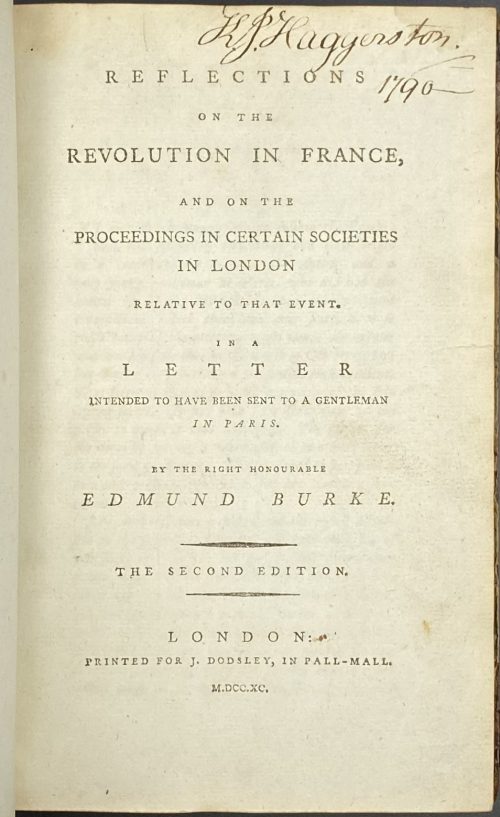 Title: REFLECTIONS | ON THE | REVOLUTION IN FRANCE, | AND ON THE | PROCEEDINGS IN CERTAIN SOCIETIES | IN LONDON | RELATIVE TO THAT EVENT. | IN A | LETTER | INTENDED TO HAVE BEEN SENT TO A GENTLEMAN | IN PARIS. | BY THE RIGHT HONOURABLE | EDMUND BURKE. | — | {in lozenges} THE SECOND EDITION. | —| LONDON: | PRINTED FOR J. DODSLEY, IN PALL-MALL. | M.DCC.XC. || Pagination: [4 blanks] [i-iii] iv, 1-356 [4 blanks]. Collation: 8vo; π2 B-Z8, Aa2. Binding: Quarter calf with marbled boards, gilt fillets, red label with gilt lettering to spine. "King John Haggerston, 1790" handwritten ink inscription to front endpaper, t.p. and p. iii. Seems like Sir John Haggerston, 9th Baronet.
Title: REFLECTIONS | ON THE | REVOLUTION IN FRANCE, | AND ON THE | PROCEEDINGS IN CERTAIN SOCIETIES | IN LONDON | RELATIVE TO THAT EVENT. | IN A | LETTER | INTENDED TO HAVE BEEN SENT TO A GENTLEMAN | IN PARIS. | BY THE RIGHT HONOURABLE | EDMUND BURKE. | — | {in lozenges} THE SECOND EDITION. | —| LONDON: | PRINTED FOR J. DODSLEY, IN PALL-MALL. | M.DCC.XC. || Pagination: [4 blanks] [i-iii] iv, 1-356 [4 blanks]. Collation: 8vo; π2 B-Z8, Aa2. Binding: Quarter calf with marbled boards, gilt fillets, red label with gilt lettering to spine. "King John Haggerston, 1790" handwritten ink inscription to front endpaper, t.p. and p. iii. Seems like Sir John Haggerston, 9th Baronet. -
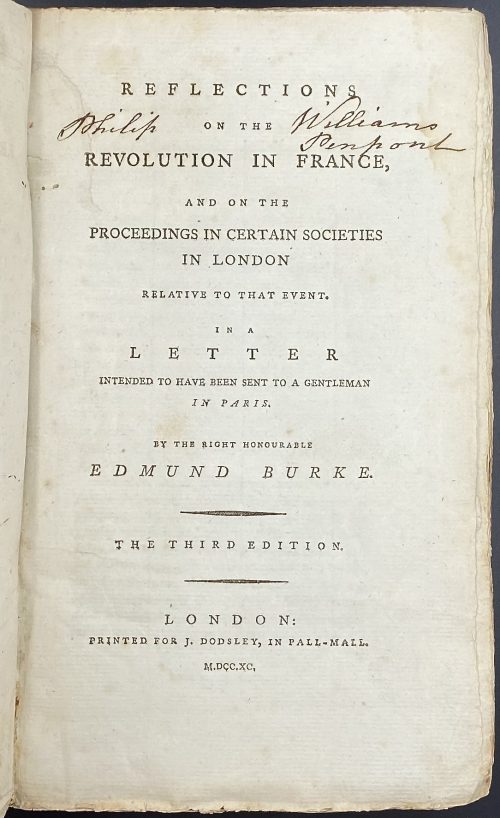 Title: REFLECTIONS | ON THE | REVOLUTION IN FRANCE, | AND ON THE | PROCEEDINGS IN CERTAIN SOCIETIES | IN LONDON | RELATIVE TO THAT EVENT. | IN A | LETTER | INTENDED TO HAVE BEEN SENT TO A GENTLEMAN | IN PARIS. | BY THE RIGHT HONOURABLE | EDMUND BURKE. | — | {in lozenges} THE THIRD EDITION. | —| LONDON: | PRINTED FOR J. DODSLEY, IN PALL-MALL. | M.DCC.XC. || Pagination: [i-iii] iv, [1] 2-364, total 368 pages. Collation: 8vo; π2 B-Z8 Aa6 (plus one blank flyleaf in the front and one in the back), total 184 leaves. Binding: 23 x 14.5 cm, publisher’s paper-backed binding in blue boards with handwritten title to spine (illegible), laid paper, margins untrimmed. Housed in a modern brown cloth clamshell box with brown gilt-lettered label. Note: The second edition same year has a total of 360 pages (iv, 356); see LIB-2590.2021. Inscription to title page: Philip [ON THE] Williams Penpont – that is probably of Philip Williams Esq., of Penpont, Breconshire, Wales. (c. 1742 – 1794).
Title: REFLECTIONS | ON THE | REVOLUTION IN FRANCE, | AND ON THE | PROCEEDINGS IN CERTAIN SOCIETIES | IN LONDON | RELATIVE TO THAT EVENT. | IN A | LETTER | INTENDED TO HAVE BEEN SENT TO A GENTLEMAN | IN PARIS. | BY THE RIGHT HONOURABLE | EDMUND BURKE. | — | {in lozenges} THE THIRD EDITION. | —| LONDON: | PRINTED FOR J. DODSLEY, IN PALL-MALL. | M.DCC.XC. || Pagination: [i-iii] iv, [1] 2-364, total 368 pages. Collation: 8vo; π2 B-Z8 Aa6 (plus one blank flyleaf in the front and one in the back), total 184 leaves. Binding: 23 x 14.5 cm, publisher’s paper-backed binding in blue boards with handwritten title to spine (illegible), laid paper, margins untrimmed. Housed in a modern brown cloth clamshell box with brown gilt-lettered label. Note: The second edition same year has a total of 360 pages (iv, 356); see LIB-2590.2021. Inscription to title page: Philip [ON THE] Williams Penpont – that is probably of Philip Williams Esq., of Penpont, Breconshire, Wales. (c. 1742 – 1794).


